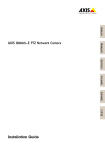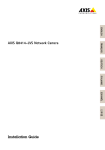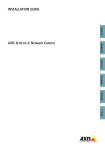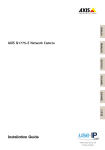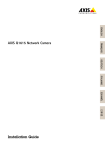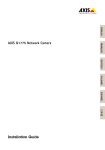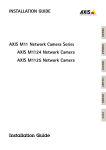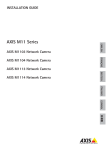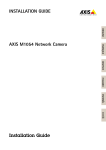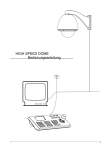Download AXIS P7216 Video Encoder Installation Guide
Transcript
ENGLISH FRANÇAIS AXIS P7216 Video Encoder DEUTSCH ITALIANO ESPANÕL ò ¨ ¾ Installation Guide Legal Considerations Support Video and audio surveillance can be regulated by laws that vary from country to country. Check the laws in your local region before using this product for surveillance purposes. This product includes one (1) H.264 decoder license and one (1) AAC decoder license. To purchase further licenses, contact your reseller. Should you require any technical assistance, please contact your Axis reseller. If your questions cannot be answered immediately, your reseller will forward your queries through the appropriate channels to ensure a rapid response. If you are connected to the Internet, you can: • download user documentation and software updates • find answers to resolved problems in the FAQ database. Search by product, category, or phrase • report problems to Axis support staff by logging in to your private support area • chat with Axis support staff (selected countries only) • visit Axis Support at www.axis.com/techsup/ Liability Every care has been taken in the preparation of this document. Please inform your local Axis office of any inaccuracies or omissions. Axis Communications AB cannot be held responsible for any technical or typographical errors and reserves the right to make changes to the product and manuals without prior notice. Axis Communications AB makes no warranty of any kind with regard to the material contained within this document, including, but not limited to, the implied warranties of merchantability and fitness for a particular purpose. Axis Communications AB shall not be liable nor responsible for incidental or consequential damages in connection with the furnishing, performance or use of this material. This product is only to be used for its intended purpose. Intellectual Property Rights Axis AB has intellectual property rights relating to technology embodied in the product described in this document. In particular, and without limitation, these intellectual property rights may include one or more of the patents listed at www.axis.com/patent.htm and one or more additional patents or pending patent applications in the US and other countries. This product contains licensed third-party software. See the menu item “About” in the product’s user interface for more information. This product contains source code copyright Apple Computer, Inc., under the terms of Apple Public Source License 2.0 (see www.opensource.apple.com/apsl). The source code is available from https://developer.apple.com/bonjour/ Equipment Modifications This equipment must be installed and used in strict accordance with the instructions given in the user documentation. This equipment contains no user-serviceable components. Unauthorized equipment changes or modifications will invalidate all applicable regulatory certifications and approvals. Trademark Acknowledgments AXIS COMMUNICATIONS, AXIS, ETRAX, ARTPEC and VAPIX are registered trademarks or trademark applications of Axis AB in various jurisdictions. All other company names and products are trademarks or registered trademarks of their respective companies. Apple, Boa, Apache, Bonjour, Ethernet, Internet Explorer, Linux, Microsoft, Mozilla, Real, SMPTE, QuickTime, UNIX, Windows, Windows Vista and WWW are registered trademarks of the respective holders. Java and all Java-based trademarks and logos are trademarks or registered trademarks of Oracle and/or its affiliates. UPnPTM is a certification mark of the UPnPTM Implementers Corporation. SD, SDHC and SDXC are trademarks or registered trademarks of SD-3C, LLC in the United States, other countries or both. Also, miniSD, microSD, miniSDHC, microSDHC, microSDXC are all trademarks or registered trademarks of SD-3C, LLC in the United States, other countries or both. Learn More! Visit Axis learning center www.axis.com/academy/ for useful trainings, webinars, tutorials and guides. Regulatory Information Europe This product complies with the applicable CE marking directives and harmonized standards: • Electromagnetic Compatibility (EMC) Directive 2004/108/EC. See Electromagnetic Compatibility (EMC) on page 2 . • Low Voltage (LVD) Directive 2006/95/EC. See Safety on page 3 . • Restrictions of Hazardous Substances (RoHS) Directive 2011/65/EU. See Disposal and Recycling on page 3 . A copy of the original declaration of conformity may be obtained from Axis Communications AB. See Contact Information on page 3 . Electromagnetic Compatibility (EMC) This equipment has been designed and tested to fulfill applicable standards for: • Radio frequency emission when installed according to the instructions and used in its intended environment. • Immunity to electrical and electromagnetic phenomena when installed according to the instructions and used in its intended environment. USA This equipment has been tested using a shielded network cable (STP) and found to comply with the limits for a Class B digital device, pursuant to part 15 of the FCC Rules. These limits are designed to provide reasonable protection against harmful interference in a residential installation. This equipment generates, uses and can radiate radio frequency energy and, if not installed and used in accordance with the instructions, may cause harmful interference to radio communications. However, there is no guarantee that interference will not occur in a particular installation. If this equipment does cause harmful interference to radio or television reception, which can be determined by turning the equipment off and on, the user is encouraged to try to correct the interference by one or more of the following measures: • Reorient or relocate the receiving antenna. • Increase the separation between the equipment and receiver. • Connect the equipment into an outlet on a circuit different from that to which the receiver is connected. • Consult the dealer or an experienced radio/TV technician for help. The product shall be connected using a shielded network cable (STP) that is properly grounded. Canada This Class B digital apparatus complies with Canadian ICES-003. The product shall be connected using a shielded network cable (STP) that is properly grounded. Cet appareil numérique de la classe B est confome à la norme NMB-003 du Canada. Le produit doit être connecté à l'aide d'un câble réseau blindé (STP) qui est correctement mis à la terre. Europe This digital equipment fulfills the requirements for RF emission according to the Class B limit of EN 55022. The product shall be connected using a shielded network cable (STP) that is properly grounded. This product fulfills the requirements for immunity according to EN 61000-6-1 residential, commercial and light-industrial environments. This product fulfills the requirements for immunity according to EN 61000-6-2 industrial environments. Australia/New Zealand This digital equipment fulfills the requirements for RF emission according to the Class B limit of AS/NZS CISPR 22. The product shall be connected using a shielded network cable (STP) that is properly grounded. Japan この装置は、クラスB 情報技術装置です。この装置 は、家庭環境で使用することを目 的としています が、この装置がラジオやテレビジョン受信機に近 接して使用されると、 受信障害を引き起こすこと があります。 取扱説明書に従って正しい取り扱い をして下さい。 本製品は、シールドネットワーク ケーブル(STP)を使用して接続してください。また 適切に接地してください。 Korea 이 기기는 가정용(B급) 전자파적합기기로서 주로 가정에서 사용하는 것을 목적으로 하며, 모든 지 역에서 사용할 수 있습니다. 적절히 접지된 STP (shielded twisted pair) 케이블을 사용하여 제품 을 연결 하십시오. Safety This product complies with IEC/EN/UL 60950-1, Safety of Information Technology Equipment. If its connecting cables are routed outdoors, the product shall be grounded either through a shielded network cable (STP) or other appropriate method. The power supply used with this product shall fulfill the requirements for Safety Extra Low Voltage (SELV) and Limited Power Source (LPS) according to IEC/EN/UL 60950-1. Disposal and Recycling When this product has reached the end of its useful life, dispose of it according to local laws and regulations. For information about your nearest designated collection point, contact your local authority responsible for waste disposal. In accordance with local legislation, penalties may be applicable for incorrect disposal of this waste. Europe This symbol means that the product shall not be disposed of together with household or commercial waste. Directive 2012/19/EU on waste electrical and electronic equipment (WEEE) is applicable in the European Union member states. To prevent potential harm to human health and the environment, the product must be disposed of in an approved and environmentally safe recycling process. For information about your nearest designated collection point, contact your local authority responsible for waste disposal. Businesses should contact the product supplier for information about how to dispose of this product correctly. This product complies with the requirements of Directive 2011/65/EU on the restriction of the use of certain hazardous substances in electrical and electronic equipment (RoHS). China This product complies with the requirements of the legislative act Administration on the Control of Pollution Caused by Electronic Information Products (ACPEIP). Contact Information Axis Communications AB Emdalavägen 14 223 69 Lund Sweden Tel: +46 46 272 18 00 Fax: +46 46 13 61 30 www.axis.com AXIS P7216 Video Encoder Safety Information Read through this Installation Guide carefully before installing the product. Keep the Installation Guide for future reference. Hazard Levels DANGER Indicates a hazardous situation which, if not avoided, will result in death or serious injury. WARNING Indicates a hazardous situation which, if not avoided, could result in death or serious injury. CAUTION Indicates a hazardous situation which, if not avoided, could result in minor or moderate injury. NOTICE TICE NO Indicates a situation which, if not avoided, could result in damage to property. Other Message Levels Important Indicates significant information which is essential for the product to function correctly. Note Indicates useful information which helps in getting the most out of the product. 4 AXIS P7216 Video Encoder Safety Instructions • To use the Axis product outdoors, or in similar environments, it shall be installed in an approved outdoor housing. • Store the Axis product in a dry and ventilated environment. • Avoid exposing the Axis product to shocks or heavy pressure. • Do not install the product on unstable brackets, surfaces or walls. • Use only applicable tools when installing the Axis product. Excessive force could cause damage to the product. • Do not use chemicals, caustic agents, or aerosol cleaners. Use a clean cloth dampened with pure water for cleaning. • Use only accessories that comply with technical specification of the product. These can be provided by Axis or a third party. • Use only spare parts provided by or recommended by Axis. • Do not attempt to repair the product by yourself. Contact Axis support or your Axis reseller for service matters. Transportation NOTICE TICE NO • When transporting the Axis product, use the original packaging or equivalent to prevent damage to the product. Battery The Axis product uses a 3.0 V BR/CR2032 lithium battery as the power supply for its internal real-time clock (RTC). Under normal conditions this battery will last for a minimum of five years. Low battery power affects the operation of the RTC, causing it to reset at every power-up. When the battery needs replacing, a log message will appear in the product’s server report. For more information about the server report, see the product´s setup pages or contact Axis support. The battery should not be replaced unless required, but if the battery does need replacing, contact Axis support at www.axis.com/techsup for assistance. 5 ENGLISH NOTICE TICE NO • The Axis product shall be used in compliance with local laws and regulations. AXIS P7216 Video Encoder WARNING • Risk of explosion if the battery is incorrectly replaced. • Replace only with an identical battery or a battery which is recommended by Axis. • Dispose of used batteries according to local regulations or the battery manufacturer's instructions. 6 AXIS P7216 Video Encoder Installation Guide Installation Steps 1. Make sure the package contents, tools and other materials necessary for the installation are in order. See page 7 . 2. Study the hardware overview. See page 7 . 3. Study the specifications. See page 10. 4. Install the hardware. See page 14. 5. Access the product. See page 15. Package Contents • • • • • • Axis P7216 Video Encoder Power adapter model Type PS-P Mounting kit 4 surface pads 2 brackets Terminal connectors 4 I/O 6–pin connector 4 RS-485/422 2x2–pin connector Installation and Management Software CD Printed materials Installation Guide (this document) Hardware Overview 1 2 3 4 5 6 7 8 9 1 Power connector 7 ENGLISH This Installation Guide provides instructions for installing AXIS P7216 Video Encoder on your network. For other aspects of using the product, see the User Manual available at www.axis.com AXIS P7216 Video Encoder 2 3 4 5 6 7 8 9 Network connector SFP Network connector RJ45 Auxiliary connector RJ45 (maintenance) Card slot (microSD) x4 I/O terminal connector x4 RS-485/422 connector x4 Control button x4 Protective earth 1 2 9 1 2 3 4 5 6 7 8 9 8 7 3 4 6 5 Video input connector BNC x16 Network LED RJ45 Network LED SFP Network LED auxiliary Power LED Status LED 1–4 Audio out connector x4 Audio in connector 2 x4 Audio in connector 1 x4 LED Indicators LED Color Indication Network Green Steady for connection to a 1 Gbit/s network. Flashes for network activity. Amber Steady for connection to a 10/100 Mbit/s network. Flashes for network activity. Unlit No network connection. Green Steady green for normal operation. Amber Steady during startup and when restoring settings. Red Slow flash for failed upgrade. Green Normal operation. Amber Flashes green/amber during firmware upgrade. Status Power 8 AXIS P7216 Video Encoder Connectors and Buttons For specifications and operating conditions, see page 10. Each video input is terminated using a coax/BNC connector. Connect a 75 Ohm coaxial video cable; the recommended maximum length is 250 m (800 ft). Note 75 Ohm video termination can be enabled/disabled for the video input through the product's web page at Video & Audio > Camera Settings > Video termination. This termination is enabled on factory default. In cases where the product is to be connected in parallel with other equipment, for optimum video quality, it is recommended that termination be enabled for only the last device in the video signal chain. Network Connector RJ45 Ethernet connector. The unit can only use one Network interface, either an SFP module or RJ45 connector. SFP module has higher priority than the RJ45 connector. NOTICE TICE NO The product shall be connected using a shielded network cable (STP). All cables connecting the product to the network shall be intended for their specific use. Make sure that the network devices are installed in accordance with the manufacturer’s instructions. For information about regulatory requirements, see Electromagnetic Compatibility (EMC) on page 2 . I/O Connector Use with external devices in combination with, for example, tampering alarms, motion detection, event triggering, time lapse recording and alarm notifications. In addition to the 0 V DC reference point and power (DC output), the I/O connector provides the interface to: • • Digital output – For connecting external devices such as relays and LEDs. Connected devices can be activated by the VAPIX® Application Programming Interface, output buttons on the Live View page or by an Action Rule. The output will show as active (shown under System Options > Ports & Devices) if the alarm device is activated. Digital input – An alarm input for connecting devices that can toggle between an open and closed circuit, for example: PIRs, door/window contacts, glass break detectors, etc. When a signal is received the state changes and the input becomes active (shown under System Options > Ports & Devices). 9 ENGLISH BNC Connector AXIS P7216 Video Encoder Audio Connector The Axis product has the following audio connectors: • • Audio in (pink) – 3.5 mm input for a mono microphone, or a line-in mono signal. Audio out (green) – 3.5 mm output for audio (line level) that can be connected to a public address (PA) system or an active speaker with a built-in amplifier. A stereo connector must be used for audio out. RS485/RS422 Connector Two terminal blocks for RS485/RS422 serial interface used to control auxiliary equipment such as PTZ devices. SD Card Slot A microSD card (not included) can be used for local recording with removable storage. For more information, see Specifications on page 10. NOTICE TICE NO To prevent corruption of recordings, the SD card should be unmounted before removal. To unmount, go to Setup > System Options > Storage > SD Card and click Unmount. Control Button The control button is used for: • • Resetting the product to factory default settings. See page 15. Connecting to an AXIS Video Hosting System service or AXIS Internet Dynamic DNS Service. For more information about these services, see the User Manual. Specifications Operating Conditions The casing of AXIS P7216 is not approved for outdoor use. The product may only be installed in indoor environments. Product Temperature Humidity AXIS P7216 0 °C to 50 °C (32 °F to 122 °F) 20-80% RH (non-condensing) 10 AXIS P7216 Video Encoder Power Consumption DC AXIS P7216 12–28 V DC, max 22 W ENGLISH Product Connectors Power Connector 2-pin terminal block for power input. Use a Safety Extra Low Voltage (SELV) compliant limited power source (LPS) with either a rated output power limited to ≤100 W or a rated output current limited to ≤5 A. DC power input I/O Terminal Connector 6–pin terminal block for: • Digital Input • Digital Output • 0 V DC (-) Function Pin 0 V DC (-) 1 DC output 2 1 2 3 4 5 6 Notes Specifications 0 V DC Can be used to power auxiliary equipment. Note: This pin can only be used as power out. 11 12 V DC Power Max load = 50 mA AXIS P7216 Video Encoder 3– 6 Configurable (Input or Output) Digital input – Connect to pin 1 to activate, or leave floating (unconnected) to deactivate. 0 to +30 V DC Digital output – Connected to pin 1 when activated, floating (unconnected) when deactivated. If used with an inductive load, e.g. a relay, a diode must be connected in parallel with the load, for protection against voltage transients. Max load = 100 mA Max voltage = +30 V DC 1 12 V max 50 mA 2 3 4 3. 4. I/O configured as input I/O configured as output 12 AXIS P7216 Video Encoder RS-485/422 Connector Two 2-pin terminal blocks for RS485/RS422 serial interface. The serial port can be configured to support: Two-wire RS485 half duplex Four-wire RS485 full duplex Two-wire RS422 simplex Four-wire RS422 full duplex point to point communication RX/TX TX 1 2 3 4 Function Pin Notes RS485/RS422 RX/TX A 1 (RX) For full duplex RS485/RS422 (RX/TX) For half duplex RS485 RS485/RS422 RX/TX B 2 RS485/RS422 TX A 3 RS485/RS422 TX B 4 (TX) For full duplex RS485/RS422 SD Card Slot Supports microSD cards with up to 64 GB of storage. For best recording performance, use a microSDHC or microSDXC card with speed class 10. Audio Connector 3.5 mm audio connectors (stereo) Audio Input 3 2 1 1 Tip 2 Ring 3 Sleeve Microphone/Line in Balanced Microphone Cold (-) In Ground Balanced Microphone Hot (+) In/Unbalance Microphone In/Line In Audio Output Ground Line out (mono) 13 ENGLISH • • • • RS485/422 AXIS P7216 Video Encoder Install the Hardware Mount the video encoder The AXIS P7216 is supplied with a mounting kit containing brackets. The unit can be mounted in a rack or on a wall. After removing the existing 4 screws, attach the mounting brackets to the video encoder at an angle suitable for installation in a standard 1U 19” rack, or on the wall. Mounting on a wall 1. Position the video encoder against the wall with the brackets attached, and mark the four mounting holes for each bracket. 2. Drill the four mounting holes. 3. Attach the video encoder to the wall using appropriate screws. Connect the cables 1. Connect the video encoder to the network using a network cable RJ45 (NET) and/or a SFP module and optic fibre or copper networking cable. 2. Optionally connect the external input/output devices. 3. Optionally connect active speakers and/or external microphones. 4. Connect the cameras to the video inputs. 5. Connect the supplied indoor power adapter. 6. Check that the indicator LEDs indicate the correct conditions. See LED Indicators on page 8 NOTICE TICE NO Make sure the unit is properly grounded by using the grounding screw. If the unit will be used with cameras or accessories located outdoors then its ground screw should be connected to a local grounding point. Note In order to use the built-in network redundancy functionality, both the RJ45 (NET) and the SFP module must be connected. See Network Redundancy on page 15 Auxiliary Connector The video encoder is equipped with an additional RJ45 network connector. The purpose with this connector is to simplify maintenance work on the video encoder that requires connection to a computer. 14 AXIS P7216 Video Encoder Note The auxiliary connector should only be connected during maintenance work and should not be connected to the same network as the SFP/NET connectors. The video encoder have built-in network redundancy functionality. The network redundancy functionality works automatically and requires that both the SFP module and the RJ45 connector (NET) are connected. Note The auxiliary RJ45 (AUX) connector does not provide redundancy functionality. Access the Product Use the tools provided on the Installation and Management Software CD to assign an IP address, set the password and access the video stream. This information is also available from the support pages on www.axis.com/techsup/ Reset to Factory Default Settings Important Reset to factory default should be used with caution. A reset to factory default will reset all settings, including the IP address, to the factory default values. Note The installation and management software tools are available on the CD supplied with the product and from the support pages on www.axis.com/techsup To reset the product to the factory default settings: Note To reset a single channel to the original factory default settings, use the button provided in that unit’s web interface. It is also possible to reset parameters to factory default via the web interface. Go to Setup > System Options > Maintenance. Further Information The User Manual is available at www.axis.com 15 ENGLISH Network Redundancy AXIS P7216 Video Encoder Visit www.axis.com/techsup to check if there is updated firmware available for your network product. To see the currently installed firmware version, go to Setup > About. Visit Axis learning center www.axis.com/academy for useful trainings, webinars, tutorials and guides. Warranty Information For information about Axis’ product warranty and thereto related information, see www.axis.com/warranty/ 16 AXIS P7216 Video Encoder Informations sur la sécurité Lisez attentivement ce guide d'installation avant d'installer l'appareil. Conservez le guide d'installation pour toute référence ultérieure. Niveaux de risques Indique une situation dangereuse qui, si elle n'est pas évitée, entraînera le décès ou des blessures graves. AVERTISSEMENT Indique une situation dangereuse qui, si elle n'est pas évitée, pourrait entraîner le décès ou des blessures graves. ATTENTION Indique une situation dangereuse qui, si elle n'est pas évitée, pourrait entraîner des blessures légères ou modérées. A VIS Indique une situation qui, si elle n'est pas évitée, pourrait endommager l'appareil. Autres niveaux de message Important Indique les informations importantes, nécessaires pour assurer le bon fonctionnement de l'appareil. Note Indique les informations utiles qui permettront d'obtenir le fonctionnement optimal de l'appareil. 17 FRANÇAIS DANGER AXIS P7216 Video Encoder Consignes de sécurité A VIS • Le produit Axis doit être utilisé conformément aux lois et règlementations locales en vigueur. • Pour pouvoir utiliser le produit Axis à l'extérieur, ou dans des environnements similaires, il doit être installé dans un boîtier d'extérieur homologué. • Conserver ce produit Axis dans un environnement sec et ventilé. • Ne pas exposer ce produit Axis aux chocs ou aux fortes pressions. • Ne pas installer ce produit sur des supports, surfaces ou murs instables. • Utiliser uniquement des outils recommandés pour l'installation de l'appareil Axis. Une force excessive appliquée sur l'appareil pourrait l'endommager. • Ne pas utiliser de produits chimiques, de substances caustiques ou de nettoyants pressurisés. Utiliser un chiffon propre et humide pour le nettoyage. • Utiliser uniquement des accessoires conformes aux caractéristiques techniques du produit. Ceux-ci peuvent être fournis par Axis ou un tiers. • Utiliser uniquement les pièces de rechange fournies ou recommandées par Axis. • Ne pas essayer de réparer ce produit vous-même. Contacter l'assistance technique d'Axis ou votre revendeur Axis pour des problèmes liés à l'entretien. Transport A VIS • Lors du transport du produit Axis, utilisez l'emballage d'origine ou un équivalent pour éviter d'endommager le produit. Batterie Le produit Axis utilise une batterie au lithium BR/CR2032 3,0 V comme alimentation de son horloge en temps réel interne (RTC). Dans des conditions normales, cette batterie a une durée de vie minimale de cinq ans. Si la batterie est faible, le fonctionnement de l'horloge en temps réel peut être affecté et entraîner sa réinitialisation à chaque mise sous tension. Un message enregistré apparaît dans le rapport de serveur du produit lorsque la batterie doit être remplacée. Pour tout complément d'information concernant le rapport de serveur, reportez-vous aux pages de Configuration du produit ou contactez l'assistance technique d'Axis. La batterie doit être remplacée uniquement en cas de besoin, et pour ce faire, contactez l'assistance technique d'Axis à l'adresse www.axis.com/techsup pour obtenir de l'aide. 18 AXIS P7216 Video Encoder AVERTISSEMENT • Risque d'explosion si la batterie est remplacée de façon incorrecte. • Remplacez-la uniquement par une batterie identique ou une batterie recommandée par Axis. • Mettez au rebut les batteries usagées conformément aux réglementations locales ou aux instructions du fabricant de la batterie. FRANÇAIS 19 20 AXIS P7216 Video Encoder Guide d'installation Ce guide d'installation explique comment installer l'encodeur vidéo AXIS P7216 sur votre réseau. Pour toute autre information relative à l'utilisation du produit, reportez-vous au manuel de l'utilisateur disponible sur le site www.axis.com Procédures d’installation Contenu de l'emballage • • • • • • Encodeur vidéo Axis P7216 Modèle d’adaptateur secteur Type PS-P Kit de montage 4 patins de protection de surface 2 supports de fixation Connecteurs pour terminaux 4 connecteurs E/S 6 broches 4 connecteurs 2x2 broches RS-485/-422 CD d'installation et de gestion Documents imprimés Guide d'installation (ce document) 21 FRANÇAIS 1. Assurez-vous que les outils et autres matériels nécessaires à l'installation sont inclus dans l'emballage. Cf. page 21. 2. Consultez la description du matériel. Cf. page 22. 3. Étudiez les caractéristiques. Cf. page 25. 4. Installez le matériel. Cf. page 29. 5. Utilisez le produit. Cf. page 30. AXIS P7216 Video Encoder Aperçu du matériel 1 2 3 4 5 6 7 8 9 1 2 3 4 5 6 7 8 9 Connecteur d’alimentation Connecteur réseau SFP Connecteur réseau RJ45 Connecteur auxiliaire RJ45 (maintenance) Logement de carte microSD (x4) Connecteur pour terminaux d’E/S (x4) Connecteur RS-485/422 (x4) Bouton de commande (x4) Terre de protection 1 2 9 1 2 3 4 5 6 7 8 9 8 7 3 4 6 Connecteur BNC (entrée vidéo, x16) Voyant DEL réseau RJ45 Voyant DEL réseau SFP Voyant DEL réseau auxiliaire Voyant d'alimentation Voyant d'état DEL 1–4 Sortie connecteur audio x4 Entrée connecteur audio 2 x4 Entrée connecteur audio 1 x4 22 5 AXIS P7216 Video Encoder Voyants Couleur Indication Réseau Vert Fixe en cas de connexion à un réseau de 1 Gbit/s. Clignote en cas d’activité réseau. Orange Fixe en cas de connexion à un réseau de 10/100 Mbits/s. Clignote en cas d’activité réseau. Éteint Pas de connexion réseau. Vert Vert fixe en cas de fonctionnement normal. Orange Fixe pendant le démarrage et lors de la restauration des paramètres. Rouge Clignote lentement en cas d’échec de la mise à niveau. Vert Fonctionnement normal. Orange Le voyant vert/orange clignote pendant la mise à niveau du microprogramme. État Alimentation Connecteurs et boutons Pour les caractéristiques et les conditions d'utilisation, consultez page 25. Connecteur BNC Chaque entrée vidéo se termine par un connecteur coaxial/BNC. Utilisez un câble vidéo coaxial de 75 ohms ; la longueur maximale recommandée est de 250 mètres (800 pieds). Note Vous pouvez activer ou désactiver la terminaison vidéo de 75 ohms via la page Web du produit sous Video & Audio > Camera Settings > Video termination. Cette terminaison est activée par défaut. Dans les cas où le produit doit être branché en parallèle avec d’autres équipements, il est recommandé d'activer la terminaison uniquement pour le dernier appareil de la chaîne de signal vidéo afin d’obtenir une qualité vidéo optimale. Connecteur réseau Connecteur Ethernet RJ45. L'appareil ne peut utiliser qu'une seule interface réseau : un module SFP ou un connecteur RJ45. Le module SFP a une priorité plus élevée que le connecteur RJ45. 23 FRANÇAIS Voyant AXIS P7216 Video Encoder A VIS Le produit doit être connecté à l'aide d'un câble réseau blindé (STP). Tous les câbles reliant le produit au commutateur réseau doivent être destinés à leur usage spécifique. Assurez-vous que les périphériques réseau sont installés conformément aux instructions du fabricant. Pour plus d’informations sur les exigences réglementaires, consultez Electromagnetic Compatibility (EMC) on page 2 . Connecteur d'E/S Utilisez-le avec des périphériques externes associés aux applications telles que les alarmes de détérioration, la détection de mouvement, le déclenchement d'événements, l'enregistrement par intervalle de temps et les notifications d'alarme. En plus du point de référence 0 V CC et de l'alimentation (sortie CC), le connecteur d'E/S fournit une interface aux éléments suivants : • • Sortie numérique – Permet de connecter des dispositifs externes, comme des relais ou des voyants. Les appareils connectés peuvent être activés par l'interface de programmation VAPIX®, des boutons de sortie sur la page Live View (Vidéo en direct) ou par une règle d'action. La sortie est considérée comme étant active (comme indiqué dans System Options > Ports & Devices (Options du système > Ports et dispositifs)) si le dispositif d’alarme est activé. Entrée numérique – Entrée d'alarme utilisée pour connecter des dispositifs pouvant passer d'un circuit ouvert à un circuit fermé, par exemple : détecteurs infrarouge passifs, contacts de porte/fenêtre, détecteurs de bris de verre, etc. À la réception d'un signal, l'état change et l'entrée s'active (sous System Options > Ports & Devices (Options du système > Ports et dispositifs)). Connecteur audio Le produit Axis dispose des connecteurs audio suivants : • • Entrée audio (rose) : entrée de 3,5 mm pour microphone mono ou signal d’entrée mono (le canal de gauche est utilisé pour le signal stéréo). Sortie audio (verte) : sortie de 3,5 mm (sortie de ligne) qui peut être connectée à un système de sonorisation (PA) ou à un haut-parleur actif avec amplificateur intégré. Un connecteur stéréo doit être utilisé pour la sortie audio. Connecteur RS485/RS422 Deux blocs terminaux à 2 broches pour l’interface série RS485/RS422 utilisée pour commander les équipements auxiliaires, tels que les dispositifs PTZ. Emplacement pour carte SD Une carte microSD (non fournie) peut être utilisée pour l’enregistrement local sur stockage amovible. Pour en savoir plus, consultez Caractéristiques techniques page 25. 24 AXIS P7216 Video Encoder A VIS Pour éviter la corruption des enregistrements, la carte SD doit être démontée avant son retrait. Pour ce faire, rendez-vous dans Setup > System Options > Storage > SD Card (Configuration > Options du système > Stockage > Carte SD) et cliquez sur Unmount (Démonter). Bouton de commande Le bouton de commande permet de réaliser les opérations suivantes : Réinitialisation du produit aux paramètres d’usine par défaut. Cf. page 30. Connexion au service du Système d'hébergement vidéo AXIS ou au service AXIS Internet Dynamic DNS. Pour plus d'informations sur ces services, reportez-vous au Manuel de l'utilisateur. Caractéristiques techniques Conditions d'utilisation Le boîtier de l'encodeur vidéo AXIS P7216 n'est pas approuvé pour une utilisation en extérieur. Le produit doit être uniquement installé en intérieur. Produit Température Humidité AXIS P7216 0 °C à 50 °C Humidité relative 20 à 80 % (sans condensation) Consommation électrique Produit CC AXIS P7216 12–28 V CC, maxi. 22 W 25 FRANÇAIS • • AXIS P7216 Video Encoder Connecteurs Connecteur d’alimentation Bloc terminal à 2 broches pour l'alimentation. Utilisez une source d'alimentation limitée (LPS) conforme aux exigences de Très basse tension de sécurité (TBTS) dont la puissance de sortie nominale est limitée à ≤100 W ou dont le courant de sortie nominal est limité à ≤5 A. Entrée d'alimentation CC Connecteur pour terminal E/S Bloc terminal à 6 broches pour : • Entrée numérique • Sortie numérique • 0 V CC (-) Fonction Broche 0 V CC (-) 1 Sortie CC 2 1 2 3 4 5 6 Notes Caractéristiques 0 V CC Peut servir à alimenter le matériel auxiliaire. Remarque : cette broche ne peut être utilisée que comme sortie d’alimentation. 26 Alimentation 12 V CC Charge maximale = 50 mA AXIS P7216 Video Encoder 3–6 Configurable (entrée ou sortie) Entre 0 et 30 V CC Sortie numérique – Connectée à la broche 1 lorsqu'elle est activée, flotte (déconnectée) lorsqu'elle est désactivée. Si vous l’utilisez avec une charge inductive, par exemple un relais, une diode doit être connectée en parallèle avec la charge, en guise de protection contre les tensions transitoires. Charge maximale = 100 mA Tension maximale= +30 V DC 1 12 V max 50 mA 2 3 4 3. 4. Entrée/sortie configurée comme entrée Entrée/sortie configurée comme sortie 27 FRANÇAIS Entrée numérique – Connectez-la à la broche 1 pour l’activer ou laissez-la flotter (déconnectée) pour la désactiver. AXIS P7216 Video Encoder Connecteur RS-485/422 Blocs terminaux à 2 broches pour interface série RS485/RS422. Le port série peut être configuré pour la prise en charge de : • • • • RS485/422 RS485 semi-duplex sur deux fils RS485 duplex intégral sur quatre fils RS422 simplex sur deux fils RS422 duplex intégral sur quatre fils pour communication point à point RX/TX TX 1 2 3 4 Fonction Broche Notes RS485/RS422 RX/TX A 1 (RX) Pour duplex intégral RS485/RS422 (RX/TX) pour semi-duplex RS485 RS485/RS422 RX/TX B 2 RS485/RS422 TX A 3 RS485/RS422 TX B 4 (TX) Pour duplex intégral RS485/RS422 Emplacement pour carte SD Prise en charge des cartes microSD jusqu'à 64 Go. Pour des performances d'enregistrement optimales, utilisez une carte microSDHC ou microSDXC de classe 10. Connecteur audio Connecteurs audio 3,5 mm (stéréo) 3 28 2 1 AXIS P7216 Video Encoder 1 Embout 2 Anneau 3 Manche Entrée audio Entrée micro/ligne Entrée microphone équilibrée négative Mise à la terre Sortie audio Sortie ligne (mono) Entrée positive microphone équilibrée/Entrée déséquilibrée micro/Entrée ligne Mise à la terre FRANÇAIS Installation du matériel Montage de l’encodeur vidéo L’encodeur vidéo AXIS P7216 est fourni avec un kit de montage contenant des supports. L’appareil peut être monté dans un rack ou sur un mur. Après avoir retiré les 4 vis, fixez les supports de fixation à l’encodeur vidéo à un angle adapté pour une installation dans un rack standard 1U 19 pouces (482,6 mm) ou sur un mur. Montage mural 1. Placez l’encodeur vidéo contre le mur avec les supports et marquez l’emplacement des quatre trous de fixation des supports. 2. Percez les quatre trous de fixation. 3. Fixez l’encodeur vidéo au mur à l’aide des vis appropriées. Branchement des câbles 1. Branchez l’encodeur vidéo sur le réseau à l’aide d’un câble réseau RJ45 (NET) et/ou d’un module SFP et d'un câble réseaux cuivre ou fibre optique. 2. Si vous le souhaitez, connectez des périphériques d’entrée/de sortie externes. 3. Si vous le souhaitez, vous pouvez brancher des haut-parleurs actifs et/ou des microphones externes. 4. Branchez les caméras aux entrées vidéo. 5. Branchez l'adaptateur d'alimentation d'intérieur fourni. 6. Vérifiez que les voyants DEL indiquent le bon état de fonctionnement. Cf. Voyants page 23 29 AXIS P7216 Video Encoder A VIS Assurez-vous que l'appareil est convenablement mis à la terre à l'aide de la vis de mise à la terre. Si l'appareil est destiné à être utilisé avec des caméras ou des accessoires situés en extérieur, sa vis de mise à la terre doit être connectée à un point mis à la terre local. Note Afin d’utiliser la fonction intégrée de redondance du réseau, le connecteur RJ45 (NET) et le module SFP doivent être connectés. Cf. Redondance de réseau page 30 Connecteur auxiliaire L'encodeur vidéo est équipé d'un connecteur réseau RJ45 supplémentaire. Ce connecteur a pour vocation de simplifier les opérations de maintenance sur l'encodeur vidéo, qui nécessite une connexion à un ordinateur. Note Le connecteur auxiliaire ne doit être connecté que lors des opérations de maintenance et ne doit pas être connecté au même réseau que les connecteurs SFP/NET. Redondance de réseau L'encodeur vidéo dispose d'une fonction de redondance du réseau intégrée. La fonction intégrée de redondance du réseau est automatique et nécessite que le connecteur SFP et le connecteur RJ45 (NET) soient connectés. Note Le connecteur auxiliaire RJ45 (AUX) n'offre pas la fonction de redondance. Accès au produit Utilisez les outils fournis sur le CD d'installation et de gestion pour attribuer une adresse IP, configurer le mot de passe et accéder au flux de données vidéo. Ces informations sont également disponibles sur les pages d'assistance technique du site www.axis.com/techsup Réinitialisation aux paramètres d'usine par défaut Important La réinitialisation aux paramètres par défaut doit être utilisée avec prudence. Cette opération reconfigure tous les paramètres, y compris l'adresse IP, aux valeurs d'usine par défaut. 30 AXIS P7216 Video Encoder Note Les logiciels d'installation et de gestion sont disponibles sur le CD fourni avec le produit et sur les pages d'assistance du site www.axis.com/techsup Pour réinitialiser l'appareil aux paramètres d'usine par défaut : Note Pour rétablir les valeurs d’usine par défaut sur un seul canal, utilisez le bouton fourni dans l'interface Web. Pour obtenir plus de renseignements Le Manuel de l'utilisateur est disponible à l'adresse suivante : www.axis.com Consultez le site www.axis.com/techsup pour vérifier si des mises à jour des logiciels sont disponibles pour votre appareil réseau. Pour connaître la version du micrologiciel actuellement installée, reportez-vous à la page Setup > About (Configuration > À propos de). Visitez le centre d'apprentissage en ligne Axis sur le site www.axis.com/academy pour en savoir plus sur les formations, les webinaires, les tutoriels et les guides. Informations sur la garantie Pour obtenir plus d'amples informations sur la garantie du produit AXIS et des renseignements connexes, allez sur le site www.axis.com/warranty/ 31 FRANÇAIS Il est également possible de rétablir les paramètres d’usine à partir de l’interface Web. Accédez à Setup > System Options > Maintenance (Configuration > Options du système > Maintenance) (Configuration > Configuration du contrôleur supplémentaire > Configuration > Options du système > Maintenance). AXIS P7216 Video Encoder Sicherheitsinformation Lesen Sie das Installationshandbuch sorgfältig durch bevor sie das Produkt installieren. Bewahren Sie das Installationshandbuch für zukünftige Zwecke auf. Gefährdungsstufen GEFAHR Weist auf eine gefährliche Situation hin, die, falls nicht verhindert, zu Tod oder schweren Verletzungen führt. WARNUNG Weist auf eine gefährliche Situation hin, welche, falls nicht verhindert, zu Tod oder schweren Verletzungen führen kann. VORSICHT Weist auf eine gefährliche Situation hin, welche, falls nicht verhindert, zu geringfügiger oder mäßiger Verletzung führen kann. HINWEIS Weist auf eine gefährliche Situation hin, welche, falls nicht verhindert, zu Sachschäden führen kann. Weitere Nachrichtenstufen Wichtig Weist auf wichtige Informationen hin, die den richtigen Betrieb des Produkts gewährleisten. Beachten Weist auf nützliche Informationen hin, die die optimale Verwendung des Produkts unterstützen. 32 AXIS P7216 Video Encoder Sicherheitsanweisungen HINWEIS • Die Anwendung des Axis Produkts muss unter Beachtung der örtlich geltenden rechtlichen Bestimmungen erfolgen. • Bei der Anwendung von Axis Produkten im Außenbereich oder ähnlichen Umgebungen, müssen diese in zugelassenen Außengehäusen installiert werden. • Lagern Sie das Axis Produkt in einer trockenen und belüfteten Umgebung. • Achten Sie darauf, dass das Axis Produkt weder Stößen noch starkem Druck ausgesetzt ist. • Installieren Sie das Produkt nicht an instabilen Halterungen, Oberflächen oder Wänden. • Verwenden Sie bei der Installation des Axis Produkts ausschließlich passende Werkzeuge. Ein zu großer Kraftaufwand kann das Produkt beschädigen. • Verwenden Sie nur Zubehör, das den technischen Daten des Produkts entspricht. Dieses ist von Axis oder Drittanbietern erhältlich. • Verwenden Sie ausschließlich Ersatzteile die von Axis bereitgestellt oder empfohlen werden. • Versuchen Sie nicht, das Produkt selbstständig zu reparieren. Wenden Sie sich bezüglich Reparatur und Wartung an den Axis Support oder Ihren Axis Händler. Transport HINWEIS • Bei Bedarf transportieren Sie das Axis Produkt in der Originalverpackung oder einer entsprechenden Verpackung, so dass Schäden vermieden werden. Batterie Das Axis-Produkt ist mit einer 3,0 V-BR/CR2032-Lithium-Batterie ausgestattet, mit der die interne Echtzeituhr (RTC) versorgt wird. Unter normalen Bedingungen hat die Batterie eine Lebensdauer von mindestens fünf Jahren. Bei entladener Batterie ist der Betrieb der Echtzeituhr nicht mehr gewährleistet, sodass die Uhr bei jedem Systemstart zurückgesetzt wird. Sie erhalten eine Protokollnachricht im Serverbericht des Produkts, wenn ein Batteriewechsel erforderlich ist. Weitere Informationen über den Serverbericht finden Sie auf den Setup-Seiten des Produkts, oder wenden Sie sich an den Axis-Support. Die Batterie sollte nur bei Bedarf ersetzt werden. Wenden Sie sich in diesem Fall an den Axis Support unter www.axis.com/techsup. 33 DEUTSCH • Verwenden Sie keine chemischen, ätzenden oder aerosolhaltigen Reinigungsmittel. Verwenden Sie zum Reinigen ein sauberes, mit lauwarmem Wasser angefeuchtetes Tuch. AXIS P7216 Video Encoder WARNUNG • Explosionsgefahr bei fehlerhaftem Batteriewechsel. • Die Batterie darf nur durch eine identische Batterie oder eine von Axis empfohlene Batterie ersetzt werden. • Verbrauchte Batterien sind gemäß den örtlichen Vorschriften oder den Anweisungen des Herstellers zu entsorgen. 34 AXIS P7216 Video Encoder Installationsanleitung In dieser Anleitung wird die Installation des Video-Encoders AXIS P7216 in einem Netzwerk beschrieben. Weitere Informationen zur Nutzung dieses Produkts finden Sie im Benutzerhandbuch unter www.axis.com. Installationsschritte 1. Stellen Sie sicher, dass die Packungsinhalte, Werkzeuge und andere notwendige Materialien für die Installation in Ordnung sind. Siehe Seite 35. 2. Machen Sie sich mit der Hardware-Übersicht vertraut. Siehe Seite 36. 3. Machen Sie sich mit den technischen Daten vertraut. Siehe Seite 39. 4. Installieren Sie die Hardware. Siehe Seite 43. 5. Zugriff auf das Produkt. Siehe Seite 44. • • • • • • Axis P7216 Video-Encoder Netzteilmodell Typ PS-P Montagesatz 4 Oberflächenpolster 2 Halterungen Terminalanschlüsse 4 E/A 6-poliger Anschluss 4 RS-485/422 2x2–poliger Anschluss CD-ROM mit Installations- und Verwaltungssoftware Dokumente Installationsanleitung (dieses Dokument) 35 DEUTSCH Lieferumfang AXIS P7216 Video Encoder Übersicht über die Hardware 1 2 3 4 5 6 7 8 9 1 2 3 4 5 6 7 8 9 Netzanschluss Netzwerkanschluss SFP Netzwerkanschluss RJ45 Zusatzanschluss RJ45 (Wartung) Kartensteckplatz (microSD) x4 E/A-Terminalanschluss x4 RS-485/422-Anschluss x4 Steuertaste x4 Schutzerde 1 2 9 1 2 3 4 5 6 7 8 9 8 7 3 4 6 Anschluss für Videoeingang BNC x16 Netzwerk-LED RJ45 Netzwerk-LED SFP Netzwerk-LED Zusatz Netz-LED Status-LED 1-4 Anschluss für Audioausgang x4 Anschluss für Audioeingang 2 x4 Anschluss für Audioeingang 1 x4 36 5 AXIS P7216 Video Encoder LED-Anzeigen Farbe Bedeutung Netz-werk Grün Leuchtet bei Verbindung mit einem 1 GBit/s-Netzwerk. Blinkt bei Netzwerkaktivität. Gelb Leuchtet bei Verbindung mit einem 10/100 MBit/s-Netzwerk. Blinkt bei Netzwerkaktivität. Leuchtet nicht Keine Netzwerkverbindung vorhanden. Grün Leuchtet bei Normalbetrieb grün. Gelb Leuchtet beim Start und beim Wiederherstellen der Einstellungen. Rot Blinkt langsam bei einem Aktualisierungsfehler. Grün Normaler Betrieb. Gelb Blinkt grün/gelb bei der Firmware-Aktualisierung. Status Stromversorgung Anschlüsse und Tasten Für die technischen Daten und Betriebsbedingungen siehe Seite 39. BNC-Anschluss Jeder Videoeingang wird mit einem Koaxial-/BNC-Anschluss abgeschlossen. Schließen Sie ein 75-Ohm-Koaxialvideokabel an. Die empfohlene maximale Kabellänge beträgt 250 m. Beachten Für den Videoeingang kann der 75-Ohm-Videoabschluss auf der Produkt-Webseite unter Video & Audio > Camera Settings > Video termination (Video und Audio > Kameraeinstellungen > Videoabschluss) aktiviert/deaktiviert werden. In den Standardwerkseinstellungen ist dieser Abschluss aktiviert. Falls das Produkt parallel zu anderen Geräten angeschlossen wird, sollte der Videoabschluss nur für das letzte Gerät in der Videosignalkette aktiviert werden, um eine optimale Videoqualität zu gewährleisten. Netzwerkanschluss RJ45-Ethernetanschluss. Diese Einheit kann nur eine Netzwerkschnittstelle verwenden: entweder ein SFP-Modul oder den RJ45-Anschluss. Das SFP-Modul hat eine höhere Priorität als der RJ45-Anschluss. 37 DEUTSCH LED AXIS P7216 Video Encoder HINWEIS Das Produkt muss mit einem abgeschirmten Netzwerkkabel (STP) angeschlossen werden. Alle Kabel, die das Produkt mit dem Netzwerkswitch verbinden, müssen hierfür ausgelegt sein. Stellen Sie sicher, dass die Netzwerkgeräte gemäß den Anweisungen des Herstellers installiert wurden. Informationen zu gesetzlichen Bestimmungen finden Sie unter Electromagnetic Compatibility (EMC) on page 2 . E/A-Anschluss Zur Verwendung mit externen Geräten in Verbindung mit Manipulationsalarmen, Bewegungserkennung, Ereignisauslösung, Zeitrafferaufnahmen, Alarmbenachrichtigungen usw. Abgesehen vom 0 V DC-Bezugspunkt und Strom (Gleichstromausgang) verfügt die E/A-Klemmenleiste über eine Schnittstelle zu: • • Digitalausgang – zum Anschluss externer Geräte wie Relais und LEDs. Angeschlossene Geräte können über die VAPIX® Application Programming Interface (Programmierschnittstelle) mit den Schaltflächen für den Ausgang auf der Seite „Live View” oder durch eine Aktionsregel aktiviert werden. Der Ausgang wird als aktiv (siehe System Options > Ports & Devices (Systemoptionen > Anschlüsse und Geräte)) angezeigt, wenn das Alarmmeldegerät aktiviert ist. Digitaleingang – Alarmeingang für den Anschluss von Geräten, die zwischen geöffnetem und geschlossenem Schaltkreis wechseln können, z. B.: PIR-Sensoren, Tür-/Fensterkontakte, Glasbruchmelder usw. Bei Empfang eines Signals ändert sich der Status und der Eingang wird aktiviert (siehe System Options > Ports & Devices (Systemoptionen > Anschlüsse & Geräte)). Audioanschlüsse Das Axis Produkt ist mit den folgenden Audioanschlüssen ausgestattet: • • Audioeingang (rosa) – 3,5-mm-Anschluss für ein Monomikrofon oder ein Monosignal (der linke Kanal wird von einem Stereosignal benutzt). Audioausgang (grün) – 3,5-mm-Audioausgang (Leitungspegel) zum Anschließen einer Rundrufanlage (PA) oder eines Aktivlautsprechers mit integriertem Verstärker. Für den Audioausgang muss ein Stereostecker verwendet werden. RS485-/RS422-Anschluss Zwei 2-polige Anschlussblöcke für serielle Schnittstellen vom Typ RS485/RS422 zur Steuerung von Zusatzgeräten, z. B. PTZ-Geräten. 38 AXIS P7216 Video Encoder SD-Kartensteckplatz Zur lokalen Aufzeichnung mit Wechselmedien kann eine microSD-Speicherkarte (nicht im Lieferumfang enthalten) verwendet werden. Weitere Informationen finden Sie unter Technische Daten auf Seite 39. HINWEIS Um einer Beschädigung der Aufnahmen vorzubeugen, sollte die SD-Karte vor dem mechanischen Auswerfen getrennt (deaktiviert) werden. Rufen Sie zum Trennen Setup > System Options > Storage > SD Card (Einrichtung > Systemoptionen > Speicher > SD-Karte) auf und klicken Sie auf Unmount (Trennen). Steuertaste Die Steuertaste hat folgende Funktionen: Zurücksetzen des Produkts auf Werkseinstellungen. Siehe Seite 44. Verbinden mit einem AXIS Video Hosting System-Service oder einem AXIS Internet Dynamic DNS-Service. Weitere Informationen zu diesen Diensten finden Sie in der Bedienungsanleitung. Technische Daten Betriebsbedingungen Das Gehäuse des AXIS P7216 ist nicht für den Einsatz im Außenbereich geeignet. Das Produkt darf nur in Innenräumen installiert werden. Produkt Temperatur Luftfeuchtigkeit AXIS P7216 0 °C bis 50 °C Relative Luftfeuchtigkeit 20 bis 80 % (nicht kondensierend) Stromverbrauch Produkt Gleichstrom AXIS P7216 12 bis 28 V Gleichstrom, max. 22 W 39 DEUTSCH • • AXIS P7216 Video Encoder Anschlüsse Netzanschluss 2-poliger Anschlussblock für die Stromversorgung. Verwenden Sie eine mit den Anforderungen für Schutzkleinspannung (SELV) kompatible Stromquelle mit begrenzter Leistung (LPS) mit einer Nennausgangsleistung von ≤100 W oder einem dauerhaft auf ≤5 A begrenzten Nennausgangsstrom. Gleichstromanschluss E/A-Terminalanschluss 6-poliger Anschlussblock für: • Digitaleingang • Digitalausgang • 0 V (-) Gleichstrom Funktion Kontakt 0 V (-) Gleichstrom 1 Gleichstromausgang 2 1 2 3 4 5 6 Hinweise Technische Daten 0 V Gleichstrom Kann für die Stromversorgung von Zusatzgeräten verwendet werden. Hinweis: Dieser Kontakt kann nur für den Stromausgang verwendet werden. 40 12 V Gleichstrom Max. Stromstärke = 50 mA AXIS P7216 Video Encoder Konfigurierbar (Ein- oder Ausgang) 3–6 Digitaleingang – zum Aktivieren mit Pin 1 verbinden; zum Deaktivieren nicht anschließen. 0 bis +30 V Gleichstrom Digitalausgang – bei Aktivierung mit Pin 1 verbunden; wenn deaktiviert: frei (nicht verbunden). Bei Verwendung mit einer induktiven Last, z. B. einem Relais, muss parallel zur Last zum Schutz vor Spannungsspitzen eine Diode zwischengeschaltet werden. Max. Stromstärke = 100 mA Max. Spannung = +30 V Gleichstrom 12 V max 50 mA 2 3 4 3. 4. E/A als Eingang konfiguriert E/A als Ausgang konfiguriert 41 DEUTSCH 1 AXIS P7216 Video Encoder RS485-/RS422-Anschluss Zwei 2-polige Anschlussblöcke für serielle Schnittstellen vom Typ RS485/RS422. Der serielle Anschluss kann in den folgenden Anschlussmodi konfiguriert werden: • • • • zweiadriger RS485-Halbduplex-Anschluss vieradriger RS485-Vollduplex-Anschluss zweiadriger RS422-Simplex-Anschluss vieradriger RS422-Vollduplex-Anschluss (Punkt-zu-Punkt-Verbindung) RS485/422 RX/TX TX 1 2 3 4 Funktion Kontakt Hinweise RS485/RS422 RX/TX A 1 (RX) RS485/RS422 für Vollduplex (RX/TX) RS485 für Halbduplex RS485/RS422 RX/TX B 2 RS485/RS422 TX A 3 RS485/RS422 TX B 4 (TX) RS485/RS422 für Vollduplex SD-Kartensteckplatz Unterstützt microSD-Karten mit bis zu 64 GB Speicherplatz. Verwenden Sie eine microSDHC- oder microSDXC-Karte der Geschwindigkeitsklasse 10, um optimale Aufzeichnungsergebnisse zu erzielen. Audioanschlüsse 3,5-mmAudioanschlüsse (stereo) Audioeingang 3 1 1 Spitze 2 Ring 3 Schaft Mikrofon-/Leitungseingang Symmetrischer Mikrofon-Minuseingang (–) Masse Symmetrischer Mikrofon-Pluseingang (+)/unsymmetrischer Mikrofon-/Leitungseingang Audioausgang 2 Masse Leitungsausgang (mono) 42 AXIS P7216 Video Encoder Installieren der Hardware Montage des Video-Encoders Der AXIS P7216 wird mit einem Montagesatz geliefert, der Halterungen enthält. Die Einheit kann in einem Rack oder an einer Wand montiert werden. Nachdem Sie die vier Schrauben entfernt haben, befestigen Sie die Halterungen am Video-Encoder in einem Winkel, bei dem die Installation in einem Standard-1U 19”-Geräterack oder an der Wand möglich ist. Montage an einer Wand Anschließen der Kabel 1. Verbinden Sie den Video-Encoder über ein RJ45-Netzwerkkabel (NET) und/oder SFP-Modul und Glasfaser- oder Kupfernetzwerkkabel mit dem Netzwerk. 2. Schließen Sie ggf. die externen Ein-/Ausgabegeräte an. 3. Sie können zusätzlich einen Aktivlautsprecher und/oder ein externes Mikrofon anschließen. 4. Verbinden Sie die Kameras mit den Videoeingängen. 5. Schließen Sie das mitgelieferte Innen-Netzteil an. 6. Überprüfen Sie, ob die LED-Anzeigen die Betriebszustände korrekt angeben. Siehe LED-Anzeigen auf Seite 37. HINWEIS Stellen Sie mithilfe der Erdungsschraube sicher, dass das Gerät ordnungsgemäß geerdet ist. Wenn das Gerät mit Kameras oder Zubehör im Außeneinsatz verwendet wird, sollte seine Masseschraube mit einem lokalen Erdungspunkt verbunden sein. Beachten Um die integrierte Netzwerkredundanzfunktion verwenden zu können, müssen sowohl RJ45 (NET) als auch SFP-Modul verbunden sein. Siehe Netzwerkredundanz auf Seite 44. 43 DEUTSCH 1. Positionieren Sie den Video-Encoder mit den angebrachten Halterungen an der Wand, und markieren Sie die vier Löcher zur Montage der Halterungen. 2. Bohren Sie die vier Montagelöcher. 3. Befestigen Sie den Video-Encoder mit den vorgesehenen Schrauben an der Wand. AXIS P7216 Video Encoder Zusatzanschluss Der Video-Encoder ist mit einem zusätzlichen RJ45-Netzwerkanschluss ausgestattet. Mit diesem Anschluss können die Wartungsarbeiten am Video-Encoder vereinfacht werden, die eine Verbindung mit einem Computer erfordern. Beachten Der Zusatzanschluss sollte nur während Wartungsarbeiten und nicht an dasselbe Netzwerk wie die SFP/NET-Anschlüsse angeschlossen werden. Netzwerkredundanz Der Video-Encoder verfügt über eine integrierte Netzwerkredundanzfunktion. Die Netzwerkredundanzfunktion wird automatisch ausgeführt und erfordert, dass sowohl das SFP-Modul als auch der RJ45-Anschluss (NET) verbunden sind. Beachten Der RJ45-Zusatzanschluss (AUX) bietet keine Redundanzfunktionalität. Zugriff auf das Produkt Verwenden Sie die bereitgestellten Tools der Installations- und Management-Software-CD, um eine IP-Adresse zuzuordnen, ein Passwort einzurichten und auf den Videostream zuzugreifen. Diese Information finden Sie ebenso auf den Support-Seiten unter www.axis.com/techsup/ Zurücksetzen auf Werkseinstellungen Wichtig Das Zurücksetzen auf die Werkseinstellungen sollte mit Vorsicht verwendet werden. Beim Zurücksetzen auf die Werkseinstellungen werden alle Einstellungen einschließlich der IP-Adresse auf die Werkseinstellungen zurückgesetzt. Beachten Die Software-Tools für Installation und Verwaltung sind auf der mit dem Produkt ausgelieferten CD-ROM und über die Supportseiten unter www.axis.com/techsup verfügbar. So wird das Produkt auf die Werkseinstellungen zurückgesetzt: Beachten Um einen einzelnen Kanal auf die Werkseinstellungen zurückzusetzen, verwenden Sie die entsprechende Schaltfläche auf der Weboberfläche des Geräts. 44 AXIS P7216 Video Encoder Die Parameter können auch über die Weboberfläche auf die Werkseinstellungen zurückgesetzt werden. Rufen Sie Setup > System Options > Maintenance (Setup > Systemoptionen > Wartung) auf. Weitere Informationen Das Benutzerhandbuch finden Sie unter www.axis.com. Unter www.axis.com/techsup finden Sie Firmware-Aktualisierungen für Ihre Netzwerkprodukte. Um die aktuell installierte Firmware-Version zu sehen, gehen Sie auf Einrichten > Über. Besuchen Sie das Axis-Schulungszentrum www.axis.com/academy für anregende Schulungen, Webinare, Lernprogramme und Anleitungen. Garantieinformationen 45 DEUTSCH Informationen zur Garantie der Axis Produkte und hierzu verbundene Informationen, finden Sie unter www.axis.com/warranty/ AXIS P7216 Video Encoder Informazioni di Sicurezza Leggere questa Guida all'Installazione prima di installare il prodotto. Conservare la Guida all'Installazione per usi futuri. Livelli di pericolo PERICOLO Indica una situazione pericolosa che, se non evitata, provoca morte o lesioni gravi. AVVERTENZA Indica una situazione pericolosa che, se non evitata, può provocare la morte o lesioni gravi. ATTENZIONE Indica una situazione pericolosa che, se non evitata, può provocare lesioni medie o minori. A VVISO Indica una situazione che, se non evitata, può danneggiare la proprietà. Livelli altro messaggio Importante Indica informazioni importanti, essenziali per il corretto funzionamento del prodotto. Nota Indica informazioni utili che aiutano a ottenere il massimo dal prodotto. 46 AXIS P7216 Video Encoder Istruzioni di sicurezza A VVISO • Il prodotto Axis deve essere utilizzato in conformità alle leggi e alle disposizioni locali. • Per utilizzare il prodotto Axis in ambienti esterni, o in ambienti simili, deve essere installato in una custodia per esterni approvata. • Conservare il prodotto Axis in un ambiente asciutto e ventilato. • Evitare di esporre il prodotto Axis a urti o pressioni eccessive. • Non installare il prodotto su supporti, superfici o pareti instabili. • Utilizzare solo strumenti applicabili quando si installa il prodotto Axis. Una forza eccessiva può causare danni al prodotto. • Non utilizzare sostanze chimiche, agenti caustici o detergenti aerosol. Utilizzare un panno pulito inumidito in acqua pura per la pulizia. • Utilizzare solo accessori compatibili con le specifiche tecniche del prodotto. Questi possono essere forniti da Axis o da terze parti. • Utilizzare solo parti di ricambio fornite o consigliate da Axis. • Non tentare di riparare il prodotto da soli. Contattare l'assistenza o il rivenditore Axis per questioni relative alla manutenzione. A VVISO • Durante il trasporto del prodotto Axis, utilizzare l'imballaggio originale o equivalente per evitare danni al prodotto. Batteria Il prodotto Axis utilizza una batteria al litio da 3,0 V BR/CR2032 come alimentazione per il suo real-time clock (RTC) interno. In condizioni normali questa batteria avrà una durata minima di cinque anni. Una bassa carica della batteria influisce sul funzionamento del RTC, facendolo resettare a ogni accensione. Quando la batteria deve essere sostituita, un messaggio di registro viene visualizzato nel server report del prodotto. Per ulteriori informazioni sul server report, vedere le pagine di configurazione del prodotto o contattare l'assistenza Axis. La batteria non deve essere sostituita se non richiesto, ma nel caso in cui questo fosse necessario, contattare il supporto Axis all'indirizzo www.axis.com/techsup per assistenza. 47 ITALIANO Trasporti AXIS P7216 Video Encoder AVVERTENZA • Rischio di esplosione se la batteria viene sostituita in modo errato. • Sostituire solo con una batteria identica o una batteria consigliata da Axis. • Smaltire le batterie usate in base alle normative locali o alle istruzioni del produttore della batteria. 48 AXIS P7216 Video Encoder Guida all'installazione La presente guida all'installazione fornisce le istruzioni necessarie per installare il codificatore video AXIS P7216 nella rete in uso. Per ulteriori informazioni sull’utilizzo del prodotto, consultare la Guida per l'utente disponibile all'indirizzo www.axis.com Procedure di installazione 1. Assicurarsi che il contenuto della confezione, gli strumenti e altri materiali necessari per l'installazione siano in ordine. Consultare pagina 49. 2. Studiare la descrizione dell'hardware. Consultare pagina 50. 3. Studiare le specifiche. Consultare pagina 53. 4. Installazione dell’hardware. Consultare pagina 56. 5. Accedere al prodotto. Consultare pagina 58. Contenuto della Confezione • • • • • 49 ITALIANO • Codificatore video Axis P7216 Modello alimentatore Tipo PS-P Kit di montaggio 4 cuscinetti 2 staffe Connettori per morsetti 4 connettori I/O a 6 pin 4 connettori RS-485/422 a 2 pin CD d'installazione e gestione Materiali stampati Guida all’installazione (questo documento) AXIS P7216 Video Encoder Panoramica dell'hardware 1 2 3 4 5 6 7 8 9 1 2 3 4 5 6 7 8 9 Morsettiera di alimentazione Connettore di rete SFP Connettore di rete RJ45 Connettore ausiliario RJ45 (manutenzione) Slot per scheda (microSD) x4 Morsettiera I/O x4 Connettore RS-485/422 x4 Pulsante di comando x4 Terra di protezione 1 2 9 1 2 3 4 5 6 7 8 9 8 7 3 4 6 Connettore BNC ingresso video x16 LED di rete RJ45 LED di rete SFP LED di rete ausiliario LED di alimentazione LED di stato 1–4 Connettore uscita audio x4 Connettore ingresso audio 2 x4 Connettore ingresso audio 1 x4 50 5 AXIS P7216 Video Encoder Indicatori LED LED Colore Indicazione Rete Verde Luce fissa per connessione di rete a 1 Gbit/s. Luce lampeggiante: attività di rete. Giallo Luce fissa per connessione di rete a 10/100 Mbit/s. Luce lampeggiante: attività di rete. Spento Assenza di connessione. Verde Luce verde fissa: condizioni di normale utilizzo. Giallo Fissa durante l'avvio e quando si ripristinano le impostazioni. Rosso Luce lampeggiante lenta: aggiornamento non riuscito. Verde Normale utilizzo. Giallo Luce lampeggiante verde/gialla: aggiornamento firmware. LED di stato Alimentazione Connettori e pulsanti Per le specifiche e le condizioni di funzionamento, consultare pagina 53. Ciascun ingresso video viene terminato con un connettore coassiale BNC. Collegare un cavo video coassiale da 75 Ohm; la lunghezza massima consigliata è 250 metri (800 ft). Nota È possibile abilitare/disabilitare la terminazione video da 75 Ohm per l'ingresso video tramite la pagina Web del prodotto selezionando Video & Audio > Camera Settings > Video termination (Video e audio > Impostazioni telecamera > Terminazione video). Questa terminazione è abilitata come impostazione di fabbrica. Se il prodotto è collegato in parallelo ad altre apparecchiature, è consigliabile abilitare la terminazione solo per l'ultimo dispositivo della catena del segnale video in modo da ottenere un video di ottima qualità. Connettore di rete Connettore Ethernet RJ45. L'unità può utilizzare una sola interfaccia di rete, un modulo SFP o un connettore RJ45. Un modulo SFP ha una priorità più alta rispetto al connettore RJ45. 51 ITALIANO Connettore BNC AXIS P7216 Video Encoder A VVISO Collegare il prodotto con un cavo di rete schermato (STP). Tutti i cavi che collegano il prodotto alla rete sono destinati al loro uso specifico. Accertarsi che i dispositivi di rete siano installati secondo le istruzioni del produttore. Per maggiori informazioni sui requisiti normativi, consultare Electromagnetic Compatibility (EMC) on page 2 . Connettore I/O Utilizzare con dispositivi esterni in combinazione con, ad esempio, allarmi antimanomissione, rilevazione del movimento, attivazione di eventi, registrazione temporizzata e notifiche di allarme. Oltre al punto di riferimento 0 V CC e all'alimentazione (uscita CC), il connettore I/O fornisce l'interfaccia per: • • Uscita digitale – Per collegare dispositivi esterni come relè o LED. I dispositivi collegati possono essere attivati tramite VAPIX® API (interfaccia per la programmazione di applicazioni), tramite i pulsanti di comando della pagina Live View (Immagini dal vivo) oppure tramite l'opzione Action Rule (regola di azione). L’uscita verrà visualizzata come attiva (visualizzata in System Options (Opzioni di Sistema) > Ports & Devices (Porte e Dispositivi)) se il dispositivo di allarme è attivato. Ingresso digitale – Ingresso allarme utilizzabile per collegare le periferiche, che può passare dal circuito chiuso al circuito aperto, ad esempio: Sensori di movimento (PIR), contatti porta/finestra, rilevatori di rottura vetri e così via. Dopo la ricezione del segnale lo stato cambia e l’ingresso diventa attivo (visualizzato in System Options > Ports & Devices (Opzioni di Sistema > Porte e Dispositivi)). Connettore audio Il prodotto Axis dispone dei seguenti connettori audio: • • Ingresso audio (rosa) – Ingresso audio da 3,5 mm per microfono in mono o segnale mono line-in (il canale sinistro è usato da un segnale stereo). Uscita audio (verde) – Uscita audio da 3,5 mm (livello di linea) che può essere connessa a un sistema di indirizzo pubblico (PA) o a un altoparlante con amplificatore integrato. Per l'uscita audio è necessario usare un connettore stereo. Connettore RS485/RS422 Due morsettiere per l'interfaccia seriale RS485/RS422 utilizzate per il controllo di periferiche ausiliarie come I dispositivi PTZ. Slot per scheda SD È possibile utilizzare una scheda microSD (non inclusa) per la registrazione in modalità locale con unità di archiviazione rimovibile. Per ulteriori informazioni, consultare Specifications on page 10. 52 AXIS P7216 Video Encoder A VVISO Per prevenire il danneggiamento delle registrazioni, la scheda SD deve essere scollegata prima della rimozione. Per scollegare, andare su Setup > System Options > Storage > SD Card (Configurazione > Opzioni di sistema > Archiviazione > Scheda SD) e fare clic su Unmount (Scollega). Pulsante di comando Il pulsante di comando viene utilizzato per: • • Ripristino del prodotto alle impostazioni predefinite di fabbrica. Consultare pagina 58. Collegamento a un servizio AXIS Video Hosting System o AXIS Internet Dynamic DNS Service. Per ulteriori informazioni su questi servizi, consultare il Manuale Utente. Dati tecnici Condizioni di funzionamento L'alloggiamento del codificatore video AXIS P7216 non è approvato per l'uso in esterno. Il prodotto può essere installato solo in ambienti interni. Temperatura Umidità AXIS P7216 Da 0 °C a 50 °C 20-80% RH (umidità relativa senza condensa) Consumo energetico Prodotto CC AXIS P7216 12–28 V CC, max 22 W 53 ITALIANO Prodotto AXIS P7216 Video Encoder Connettori Connettore di alimentazione Morsettiera a 2 pin per ingresso alimentazione. Utilizzare una sorgente di alimentazione limitata (LPS) compatibile con una bassissima tensione di sicurezza (SELV) con una potenza di uscita nominale limitata a ≤100 W o una corrente nominale di uscita limitata a ≤5 A. Potenza di ingresso CC Connettore per morsetti I/O Morsettiera a 6–pin per: • Ingresso digitale • Uscita digitale • 0 V CC (-) 1 2 3 4 5 6 Funzione Pin 0 V CC (-) 1 Note Uscita CC 2 Può essere utilizzato per alimentare una periferica ausiliaria. Nota: questo pin può essere usato solo come uscita alimentazione. Alimentazione a 12 V CC Carico massimo: 50 mA Configurabile (ingresso o uscita) 3– 6 Ingresso digitale – Collegare al pin 1 per attivarlo oppure lasciarlo isolato (scollegato) per disattivarlo. Da 0 a +30 V CC Uscita digitale – Collegata al pin 1 quando attiva, isolata (scollegata) quando inattiva. Se utilizzato con un carico induttivo, ad esempio un relè esterno, è necessario collegare un diodo in parallelo al carico per proteggere il dispositivo da sovratenstioni. Carico massimo: 100 mA Tensione max.: +30 V CC Specifiche 0 V CC 54 AXIS P7216 Video Encoder 1 2 12 V max 50 mA 3 4 ITALIANO 3. 4. I/O configurato come ingresso I/O configurato come uscita Connettore RS-485/422 Due morsettiere a 2 pin per interfaccia seriale RS485/RS422. La porta seriale può essere configurata per supportare: • • • • RS485 a due fili, half-duplex RS485 a quattro fili, full-duplex RS422 a due fili, simplex Comunicazione full-duplex punto a punto con RS422 a quattro fili RS485/422 RX/TX TX 1 2 3 4 Funzione Pin Note RS485/RS422 RX/TX A 1 (RX) Per RS485/RS422 full duplex (RX/TX) Per RS485 half duplex RS485/RS422 RX/TX B 2 55 AXIS P7216 Video Encoder RS485/RS422 TX A 3 RS485/RS422 TX B 4 (TX) Per RS485/RS422 full-duplex Slot per scheda SD Supporta schede microSD con un massimo di 64 GB di archiviazione. Per ottenere prestazioni di registrazione ideali, utilizzare una scheda microSDHC o microSDXC con classe di velocità 10. Connettore audio Connettori audio da 3,5 mm (stereo) Ingresso audio 3 2 1 1 Punta 2 Anello 3 Guaina Ingresso microfono/linea Ingresso microfono bilanciato freddo (-) Terra Ingresso microfono bilanciato caldo (+)/Ingresso microfono non bilanciato/Ingresso linea Uscita audio Terra Uscita linea (mono) Installazione dell'Hardware Montaggio del codificatore video AXIS P7216 viene fornito con un kit di montaggio contenente staffe. L'unità può essere montata su un rack o una parete. Dopo aver rimosso le 4 viti presenti, fissare le staffe di montaggio al codificatore video a un'angolazione adatta per l'installazione su un rack standard 1U da 19" o a parete. Montaggio a parete 1. Appoggiare il codificatore video contro il muro con le staffe pre-montate e contrassegnare la posizione dei quattro fori di montaggio per ciascuna staffa. 2. Realizzare i quattro fori di montaggio. 3. Fissare il codificatore video al muro utilizzando le viti fornite in dotazione. 56 AXIS P7216 Video Encoder Collegamento dei cavi 1. Collegare il codificatore video alla rete mediante un cavo di rete RJ45 (NET) e/o un modulo SFP e un cavo di rete in rame o in fibra ottica. 2. Collegare facoltativamente i dispositivi esterni di ingresso/uscita. 3. Collegare facoltativamente gli altoparlanti attivi e/o i microfoni esterni. 4. Collegare le telecamere agli ingressi video. 5. Collegare l'alimentatore per interni fornito. 6. Verificare che i LED indichino le condizioni di funzionamento corrette. Consultare Indicatori LED alla pagina 51 A VVISO Accertarsi che l'unità sia correttamente messa a terra usando le apposite viti. Se l'unità verrà utilizzata con telecamere o accessori esterni, collegare la vite di terra a un punto di messa a terra locale. Nota Per utilizzare la funzionalità di ridondanza di rete, è necessario che sia il connettore RJ45 (NET) sia il modulo SFP siano collegati. Consultare Ridondanza di rete alla pagina 57 Il codificatore video è dotato di un connettore di rete RJ45 aggiuntivo. Lo scopo del connettore è semplificare l'attività di manutenzione sul codificatore video che richiede la connessione a un computer. Nota Collegare il connettore ausiliario esclusivamente durante attività di manutenzione e non collegarlo alla stessa rete dei connettori SFP/NET. Ridondanza di rete Il codificatore video dispone di funzionalità di ridondanza di rete integrata. La funzionalità di ridondanza di rete funziona in modo automatico ed è necessario che sia il modulo SFP sia il connettore RJ45 (NET) siano collegati. Nota Il connettore ausiliario RJ45 (AUX) non è dotato di funzionalità di ridondanza. 57 ITALIANO Connettore ausiliario AXIS P7216 Video Encoder Accedere al Prodotto Utilizzare le utility contenute nel CD del software d'installazione e gestione per assegnare un indirizzo IP, impostare la password ed accedere al flusso video. Queste informazioni sono disponibili anche sulle pagine dedicate all'assistenza sul sito www.axis.com/techsup/ Ripristino dei valori predefiniti di fabbrica Importante Il ripristino delle impostazioni di fabbrica deve essere usato con cautela. Un ripristino delle impostazioni di fabbrica consentirà di ripristinare le impostazioni di fabbrica per tutti i parametri, incluso l'indirizzo IP. Nota Gli strumenti software per la gestione e l'installazione del prodotto sono disponibili sul CD fornito con il prodotto e sulle pagine dedicate all'assistenza sul sito Web www.axis.com/techsup. Per ripristinare il prodotto alle impostazioni predefinite di fabbrica: Nota Per riportare alle impostazioni originali di fabbrica un solo canale, utilizzare il pulsante corrispondente nell'interfaccia Web dell'unità. È anche possibile reimpostare i parametri alle impostazioni predefinite di fabbrica mediante l’interfaccia web. Andare suSetup > System Options > Maintenance (Configurazione > Opzioni di sistema > Manutenzione). Ulteriori Informazioni Il Manuale per l'Utente è disponibile all'indirizzo www.axis.com Visitare il sito all’indirizzo www.axis.com/techsup per verificare se sono stati pubblicati aggiornamenti del firmware per il proprio prodotto di rete. Per conoscere la versione del firmware installata, andare su Setup (Impostazioni) > About (Informazioni su). Visitare il Centro di apprendimento Axis alla pagina www.axis.com/academy per servizi di formazione utili, webinar, tutorial e guide. Informazioni sulla garanzia Per informazioni sulla garanzia del prodotto Axis e informazioni ad esso relative, consultare la pagina www.axis.com/warranty/ 58 AXIS P7216 Video Encoder Información de seguridad Lea esta Guía de instalación con atención antes de instalar el producto. Guarde la Guía de instalación para poder consultarla en otro momento. Niveles de peligro PELIGRO Indica una situación peligrosa que, si no se evita, provocará lesiones graves o la muerte. ADVERTENCIA Indica una situación peligrosa que, si no se evita, puede provocar lesiones graves o la muerte. ATENCIÓN Indica una situación peligrosa que, si no se evita, puede provocar lesiones moderadas o leves. A VISO Indica una situación peligrosa que, si no se evita, puede provocar daños materiales. Otros niveles de mensaje Importante Indica información importante que es fundamental para que el producto funcione correctamente. Nota Indica información útil que ayuda a aprovechar el producto al máximo. ESPANÕL 59 AXIS P7216 Video Encoder Instrucciones de seguridad A VISO • El producto de Axis debe utilizarse de acuerdo con las leyes y normas locales. • Para usar el producto de Axis en exteriores, o en entornos similares, debe instalarse en una carcasa exterior aprobada. • Almacene el producto de Axis en un entorno seco y ventilado. • Evite la exposición del producto de Axis a choques o a una fuerte presión. • No instale el producto en soportes, superficies o paredes inestables. • Utilice solo las herramientas correspondientes cuando instale el producto de Axis. La aplicación de una fuerza excesiva puede provocar daños en el producto. • No utilice limpiadores en aerosol, agentes cáusticos ni productos químicos. Limpie con un trapo limpio humedecido con agua pura. • Utilice solo accesorios que cumplan con las especificaciones técnicas del producto. Estos accesorios los puede proporcionar Axis o un tercero. • Utilice solo piezas de repuesto proporcionadas o recomendadas por Axis. • No intente reparar el producto usted mismo. Póngase en contacto con el servicio de asistencia técnica de Axis o con su distribuidor de Axis para tratar asuntos de reparación. Transporte A VISO • Cuando transporte el producto de Axis, utilice el embalaje original o un equivalente para evitar daños en el producto. Batería Este producto de Axis utiliza una batería de litio BR/CR2032 de 3,0 V como fuente de alimentación del reloj interno en tiempo real. En condiciones normales, esta batería durará un mínimo de cinco años. Un nivel bajo de batería afectará al funcionamiento del reloj en tiempo real, lo que provocará el restablecimiento de este cada vez que se encienda el producto. Cuando sea necesario sustituir la batería, aparecerá un mensaje de registro en el informe del servidor del producto. Para obtener más información sobre el informe del servidor, vea las páginas de configuración del producto o póngase en contacto con el servicio de asistencia técnica de Axis. La batería no debe sustituirse a menos que sea necesario; no obstante, si precisa hacerlo, póngase en contacto con el servicio de asistencia técnica de Axis en www.axis.com/techsup para solicitar ayuda. 60 AXIS P7216 Video Encoder ADVERTENCIA • La sustitución incorrecta de la batería implica riesgo de explosión. • Sustituya la batería con una batería idéntica u otra batería recomendada por Axis. • Deseche las baterías usadas de conformidad con la normativa local o las instrucciones del fabricante. ESPANÕL 61 62 AXIS P7216 Video Encoder Guía de instalación En esta Guía de instalación se proporcionan las instrucciones necesarias para instalar el codificador de vídeo AXIS P7216 en la red. Para conocer otros aspectos de uso del producto, consulte el Manual del usuario disponible en www.axis.com Pasos de la instalación 1. Asegúrese de que dispone del contenido del paquete, las herramientas y los demás materiales necesarios para la instalación. Vea página 63. 2. Estudie la información general del hardware. Vea página 64. 3. Estudie las especificaciones. Vea página 67. 4. Instale el hardware. Vea página 70. 5. Acceda al producto. Vea página 72. Contenido del paquete • • • • 63 ESPANÕL • • Codificador de vídeo Axis P7216 Modelo de adaptador de alimentación Tipo PS-P Kit de montaje 4 alfombrillas para superficie 2 soportes Conectores del terminal 4 conectores E/S de 6 pines 4 conectores RS-485/422 de 2x2 pines CD del software de instalación y gestión Materiales impresos Guía de instalación (este documento) AXIS P7216 Video Encoder Información general del hardware 1 2 3 4 5 6 7 8 9 1 2 3 4 5 6 7 8 9 Conector de alimentación Conector de red SFP Conector de red RJ45 Conector auxiliar RJ45 (mantenimiento) Ranura para tarjetas (microSD) x4 Conector del terminal de E/S x4 Conector RS-485/RS-422 x4 Botón de control x4 Conexión a tierra de protección 1 2 9 1 2 3 4 5 6 7 8 9 8 7 3 4 6 Conector BNC de entrada de vídeo x16 LED de red RJ45 LED de red SFP LED de red auxiliar LED de alimentación LED de estado 1–4 4 conectores de salida de audio 4 conectores de entrada de audio 2 4 conectores de entrada de audio 1 64 5 AXIS P7216 Video Encoder Indicadores LED LED Color Indicación Red Verde Fijo para indicar una conexión a una red de 1 Gbits/s. Parpadea cuando hay actividad de red. Ámbar Fijo para indicar una conexión a una red de 10/100 Mbits/s. Parpadea cuando hay actividad de red. Apagado No hay conexión a la red. Verde Verde fijo para indicar un funcionamiento normal. Ámbar Fijo durante el inicio y al restaurar valores de configuración. Rojo Parpadea despacio si se ha producido un error en una actualización. Verde Funcionamiento normal. Ámbar Parpadea en verde/ámbar durante la actualización del firmware. Estado Alimentación Conectores y botones Para conocer las especificaciones y las condiciones de funcionamiento, vea página 67. Conector BNC Nota Se puede activar o desactivar una terminación de vídeo de 75 ohmios para la entrada de vídeo a través de la página web del producto Video & Audio > Camera Settings > Video termination (Vídeo y audio > Configuración de la cámara > Terminación de vídeo) (Vídeo > Configuración de la cámara > Terminación de vídeo). Esta terminación se activa con la configuración predeterminada de fábrica. Para obtener una calidad de vídeo óptima cuando el producto se vaya a conectar en paralelo con otros equipos, se recomienda activar la terminación solo para el último dispositivo de la cadena de señales de vídeo. Conector de red Conector Ethernet RJ45. La unidad solo puede utilizar una interfaz de red, ya sea un módulo SFP o un conector RJ45. El módulo SFP tiene mayor prioridad que el conector RJ45. 65 ESPANÕL Todas las entradas de vídeo se terminan con un conector coaxial/BNC. Conecte un cable de vídeo coaxial de 75 ohmios; la longitud máxima recomendada es de 250 m. AXIS P7216 Video Encoder A VISO El producto se conectará mediante un cable de red blindado (STP). Todos los cables que conecten el producto a la red deberán estar blindados para su uso específico. Asegúrese de que los dispositivos de red estén instalados de conformidad con las instrucciones del fabricante. Para obtener información sobre los requisitos normativos, vea Electromagnetic Compatibility (EMC) on page 2 . Conector de E/S Se utiliza con dispositivos externos combinados, por ejemplo, con alarmas antimanipulación, detección de movimiento, activación de eventos, grabación de intervalos de tiempo y notificaciones de alarma. Además del punto de referencia de 0 V CC y la potencia (salida de CC), el conector de E/S ofrece la interfaz para: • • Salida digital – para conectar dispositivos externos como relés y LED. Los dispositivos conectados se pueden activar mediante la Interfaz de programación de aplicaciones (API) VAPIX®, los botones de salida de la página Live View o mediante una regla de acción. La salida se mostrará activa (se indica en System Options > Ports & Devices (Opciones del sistema > Puertos y dispositivos)) si el dispositivo de alarma está activado. Entrada digital – una entrada de alarma para conectar dispositivos que puedan alternar circuitos cerrados y abiertos, como: detectores PIR, contactos de puertas y ventanas, detectores de rotura de cristales, etc. Cuando se recibe una señal, el estado cambia y la entrada se vuelve activa (se indica en System Options > Ports & Devices (Opciones del sistema > Puertos y dispositivos)). Conector de audio El producto de Axis integra los siguientes conectores de audio: • • Entrada de audio (rosa): entrada de 3,5 mm para micrófono mono, o entrada de línea de señal mono (se usa el canal izquierdo de una señal estéreo). Salida de audio (verde): salida para audio (nivel de línea) de 3,5 mm que se puede conectar a un sistema de megafonía pública o a un altavoz con amplificador incorporado. Debe utilizarse un conector estéreo para la salida de audio. Conector RS485/RS422 Dos bloques de terminales de 2 pines para la interfaz serie RS485/RS422 usada para controlar equipos auxiliares, como dispositivos PTZ. Ranura para tarjetas SD Puede emplearse una tarjeta microSD (no incluida) para la grabación local con almacenamiento extraíble. Para obtener más información, vea Especificaciones en la página 67. 66 AXIS P7216 Video Encoder A VISO Antes de retirar la tarjeta SD, hay que desinstalarla para evitar que las grabaciones resulten dañadas. Para desinstalarla, vaya a Setup > System Options > Storage > SD Card (Configuración > Opciones del sistema > Almacenamiento > Tarjeta SD) y haga clic en Unmount (Desinstalar). Botón de control El botón de control se utiliza para lo siguiente: • • Restablecer el producto a la configuración predeterminada de fábrica. Vea página 72. Conectarse a un servicio AXIS Video Hosting System o al Servicio de DNS dinámico de Internet de AXIS. Para obtener más información sobre estos servicios, vea el Manual del usuario. Especificaciones Condiciones de funcionamiento La carcasa del AXIS P7216 no está aprobada para su uso en exteriores. El producto solo puede instalarse en interiores. Producto Temperatura Humedad AXIS P7216 De 0 °C a 50 °C Humedad relativa del 20-80 % (sin condensación) ESPANÕL Consumo Producto CC AXIS P7216 12–28 V CC, máx. 22 W 67 AXIS P7216 Video Encoder Conectores Conector de alimentación Bloque de terminales de 2 pines para la entrada de alimentación. Use una fuente de alimentación limitada (LPS) que cumpla los requisitos de tensión muy baja de seguridad (SELV) con una potencia nominal de salida limitada a ≤100 W o una corriente nominal de salida limitada a ≤5 A. Entrada de alimentación de CC Conector del terminal de E/S Bloque de terminales de seis pines para: • Entrada digital • Salida digital • 0 V CC (-) 1 2 3 4 5 6 Función Pin Notas 0 V CC (-) 1 Salida de CC 2 Se puede utilizar para conectar el equipo auxiliar. Nota: Este pin solo se puede utilizar como salida. Alimentación 12 V CC Carga máx. = 50 mA Configurable (entrada o salida) 3– 6 Entrada digital: Conéctela al pin 1 para activarla, o bien déjela suelta (o desconectada) para desactivarla. De 0 a +30 V CC Salida digital: Conectada al pin 1 cuando se activa y suelta (sin conectar) cuando está desactivada. Si se utiliza con una carga inductiva (por ejemplo, un relé), debe conectarse un diodo en paralelo a la carga como protección ante transitorios de tensión. Carga máx. = 100 mA Voltaje máx. = +30 V CC Especificaciones 0 V CC 68 AXIS P7216 Video Encoder 1 2 12 V max 50 mA 3 4 3. 4. E/S configurada como entrada E/S configurada como salida Conector RS-485/422 • • • • Semidúplex RS485 de dos cables Dúplex completo RS485 de cuatro cables Símplex RS422 de dos cables Dúplex completo RS422 de cuatro cables para comunicación dúplex punto a punto RS485/422 RX/TX TX 1 2 3 4 Función Pin Notas RS485/RS422 RX/TX A 1 (RX) para dúplex completo RS485/RS422 (RX/TX) para semidúplex RS485 RS485/RS422 RX/TX B 2 69 ESPANÕL Dos bloques de terminales de 2 pines para la interfaz serie RS485/RS422. El puerto serie puede configurarse para admitir: AXIS P7216 Video Encoder RS485/RS422 TX A 3 RS485/RS422 TX B 4 (TX) para dúplex completo RS485/RS422 Ranura para tarjetas SD Admite tarjetas microSD de hasta 64 GB de capacidad de almacenamiento. Para obtener un rendimiento de grabación óptimo, utilice una tarjeta microSDHC o microSDXC de velocidad de clase 10. Conector de audio Conectores de audio de 3,5 mm (estéreo) 1 Punta 3 2 1 Entrada de audio Salida de audio Entrada de línea/micrófono Salida de línea (mono) Tierra Tierra 2 Anillo 3 Manguito Instalación del hardware Montaje del codificador de vídeo El AXIS P7216 se entrega con un kit de montaje que incluye los soportes. La unidad puede montarse en un bastidor o en una pared. Después de extraer los 4 tornillos, monte los soportes de montaje en el codificador de vídeo en un ángulo apropiado para la instalación en un bastidor estándar 1U de 19 pulgadas o en la pared. Montaje en pared 1. Apoye el codificador de vídeo contra la pared, con los soportes montados, y marque la posición de los cuatro orificios de montaje de cada soporte. 2. Taladre los cuatro orificios de montaje. 3. Monte el codificador de vídeo en la pared con los tornillos adecuados. 70 AXIS P7216 Video Encoder Conexión de los cables 1. Conecte el codificador de vídeo a la red mediante un cable de red RJ45 (NET) o un módulo SFP y un cable de red de fibra óptica o de cobre. 2. Si lo desea, puede conectar los dispositivos de entrada/salida externos. 3. De manera opcional, puede conectar altavoces activos y/o micrófonos externos. 4. Conecte las cámaras a las entradas de vídeo. 5. Conecte el adaptador de alimentación para uso en interiores suministrado. 6. Compruebe que los indicadores LED indican las condiciones correctas. Vea Indicadores LED en la página 65 A VISO Asegúrese de que la unidad esté conectada a tierra correctamente mediante el tornillo de toma de tierra. Si la unidad se va a utilizar con cámaras o accesorios ubicados en el exterior, entonces el tornillo de toma de tierra deberá conectarse a un punto de toma de tierra local. Nota Para poder utilizar la funcionalidad de redundancia de red integrada, tanto el conector RJ45 (NET) como el módulo SFP deben estar conectados. Vea Redundancia de red en la página 71. Conector auxiliar El codificador de vídeo está equipado con un conector de red RJ45 adicional. La finalidad de este conector es simplificar el trabajo de mantenimiento del codificador de vídeo que requiera conexión a un ordenador. El conector auxiliar solo debe conectarse durante las labores de mantenimiento y no debe conectarse a la misma red que los conectores SFP/NET. Redundancia de red El codificador de vídeo incluye funcionalidad de redundancia de red integrada. La funcionalidad de redundancia de red funciona de manera automática y necesita que tanto el módulo SFP como el conector RJ45 (NET) estén conectados. Nota El conector RJ45 auxiliar (AUX) no proporciona funcionalidad de redundancia. 71 ESPANÕL Nota AXIS P7216 Video Encoder Acceso al producto Utilice las herramientas suministradas en el CD del software de instalación y gestión para asignar una dirección IP, establecer la contraseña y acceder a la transmisión de vídeo. Esta información también está disponible en las páginas de asistencia técnica en www.axis.com/techsup/ Restablecimiento a la configuración predeterminada de fábrica Importante Hay que tener cuidado al restablecer la configuración predeterminada de fábrica. Todos los valores, incluida la dirección IP, se restablecerán a la configuración predeterminada de fábrica. Nota Las herramientas del software de instalación y gestión están disponibles en el CD suministrado con el producto, así como en las páginas de asistencia técnica en www.axis.com/techsup. Para restablecer el producto a la configuración predeterminada de fábrica: Nota Para restablecer la configuración predeterminada de fábrica original de un único canal, use el botón proporcionado en la interfaz web de dicha unidad. También es posible restablecer los parámetros a los valores predeterminados de fábrica mediante la interfaz web. Para ello, vaya a Setup > System Options > Maintenance (Configuración > Opciones del sistema > Mantenimiento). Más información El Manual de usuario se encuentra disponible en www.axis.com. Visite www.axis.com/techsup para comprobar si existe un firmware actualizado disponible para su producto de red. Para ver la versión del firmware instalado actualmente, vaya a Setup > About (Configuración > Acerca de). Visite el centro de aprendizaje de www.axis.com/academy para consultar guías, tutoriales, seminarios web y cursos que pueden resultarle útiles. Información de la garantía Para obtener más información acerca de la garantía del producto Axis e información relacionada, visite www.axis.com/warranty/ 72 AXIS P7216 Video Encoder 安全情報 本製品を設置する前に、このインストールガイドをよくお読みください。インストー ルガイドは、後で参照できるように保管しておいてください。 危険レベル 危険 回避しない場合、死亡または重傷につながる危険な状 態を示します。 警告 回避しない場合、死亡または重傷につながるおそれのあ る危険な状態を示します。 注意 回避しない場合、軽傷または中程度の怪我につながるお それのある危険な状態を示します。 注記 回避しない場合、器物の破損につながるおそれのある状 態を示します。 その他のメッセージレベル 重要 製品を正しく機能させるために不可欠な重要情報を示 します。 注意 製品を最大限に活用するために役立つ有用な情報を示 します。 ò ¨ ¾ 73 AXIS P7216 Video Encoder 安全手順 注記 • 本製品は、お使いになる地域の法律や規制に準拠して使用してください。 • 本製品を屋外またはそれに準じる環境で使用する場合は、屋外対応の認証・ 認可がある筐体に収納して設置する必要があります。 • 本製品は乾燥した換気のよい環境に保管してください。 • 本製品に衝撃または強い圧力を加えないでください。 • 本製品を不安定なブラケット、表面、または壁に設置しないでください。 • 本製品を設置する際には、適切な工具のみを使用してください。過剰な力 がかかると、製品が損傷することがあります。 • 化学薬品、腐食剤、噴霧式クリーナーは使用しないでください。清掃には、 きれいな水に浸した清潔な布を使用してください。 • 製品の技術仕様に準拠したアクセサリーのみを使用してください。これらの アクセサリーは、Axisまたはサードパーティから入手できます。 • Axisが提供または推奨する交換部品のみを使用してください。 • 製品を自分で修理しないでください。修理については、Axisサポートまたは 販売代理店にお問い合わせください。 輸送 注記 • 本製品を運搬する際は、製品が損傷しないよう、元の梱包か同等の梱包を 使用してください。 バッテリー 本製品は、内部リアルタイムクロック (RTC) 用電源として、3.0 V BR/CR2032リチウム バッテリーを使用します。このバッテリーは、通常条件下で最低5年間使用できます。 バッテリーが低電力状態になると、RTCの動作に影響し、電源を入れるたびにRTCが リセットされます。バッテリーの交換が必要になると、製品のサーバーレポートにロ グメッセージが表示されます。サーバーレポートの詳細については、製品の設定ペー ジを参照するか、Axisサポートまでお問い合わせください。 必要な場合以外はバッテリーを交換しないでください。バッテリーの交換が必要な場 合は、Axisサポート (www.axis.com/techsup) までご連絡ください。 74 AXIS P7216 Video Encoder 警告 • バッテリーは、正しく交換しないと爆発する危険があります。 • 交換用バッテリーとしては、同一品またはAxisが推奨するバッテリーのみを 使用してください。 • 使用済みバッテリーは、地域の規制またはバッテリーメーカーの指示に 従って廃棄してください。 ò ¨ ¾ 75 76 AXIS P7216 Video Encoder インストールガイド このインストールガイドでは、AXIS P7216ビデオエンコーダをネットワークにインス トールする手順について説明します。本製品の使用の詳細については、Axisのホーム ページ (www.axis.com) でユーザーズマニュアルを参照してください。 設置手順 1. パッケージの内容、ツールなど、設置に必要な物がそろっているかを確認 します。 ページ 77 を参照してください。 2. 「ハードウェアの概要」をよく読みます。 ページ 78 を参照してください。 3. 「仕様」をよく読みます。 ページ 81 を参照してください。 4. ハードウェアの設置。 ページ 85 を参照してください。 5. 製品にアクセスします。 ページ 86 を参照してください。 パッケージの内容 • • • • • • AXIS P7216ビデオエンコーダ 電源アダプターモデル ‑ PS‑Pタイプ 取り付けキット ‑ 表面パッド×4 ‑ ブラケット×2 ターミナルコネクター ‑ 6ピンI/Oコネクター×4 ‑ RS‑485/422 2×2ピンコネクター×4 インストール・管理ソフトウェアCD 印刷物 ‑ インストールガイド (本書) ò ¨ ¾ 77 AXIS P7216 Video Encoder ハードウェアの概要 1 2 3 4 5 6 7 8 9 1 2 3 4 5 6 7 8 9 電源コネクター ネットワークコネクター (SFP) ネットワークコネクター (RJ45) 補助コネクター (RJ45、保守用) microSDカードスロット×4 I/Oターミナルコネクター×4 RS‑485/422コネクター×4 コントロールボタン×4 保護アース 1 2 9 1 2 3 4 5 6 7 8 9 8 7 3 4 6 ビデオ入力コネクタ (BNC)×16 ネットワークLED (RJ45) ネットワークLED (SFP) ネットワークLED (補助コネクタ) 電源LED ステータスLED 1~4 音声出力コネクタ×4 音声入力コネクタ2×4 音声入力コネクタ1×4 78 5 AXIS P7216 Video Encoder LED イ ン ジ ケ ー タ ー LED 色 説明 ネット ワーク 緑 1Gbit/sネットワークに接続している場合、点灯します。ネッ トワークパケットを送受信した場合、点滅します。 黄 10/100Mbit/sネットワークに接続している場合、点灯します。 ネットワークパケットを送受信した場合、点滅します。 無点灯 ネットワークに接続されていません。 緑 通常動作の場合、点灯します。 黄 起動時、設定の復元時に点灯します。 赤 アップグレードに失敗すると、ゆっくりと点滅します。 緑 正常動作 黄 ファームウェアのアップグレード中、緑/黄に交互に点滅し ます。 ステー タス 電源 コネクターとボタン 仕様と動作条件については、 ページ 81 を参照してください。 BNC コ ネ ク タ ー 各ビデオ入力は、同軸/BNCコネクターを使用して終端します。75Ω同軸ビデオケー ブルを使用し、ケーブル長は250 m以下にすることをお勧めします。 注意 ネットワークコネクタ RJ45イーサネットコネクタ 本製品では、ネットワークインターフェースとして、SFPモジュール、RJ45コネクタ のどちらかのみを使用できます。SFPモジュールは、RJ45コネクタに優先します。 79 ò ¨ ¾ ビデオ入力の75Ωビデオ終端は、本製品の設定ページの [Video & Audio ‑ Camera Settings ‑ Video termination] ( ビ デ オ と 音 声 ‑ カ メ ラ 設 定 ‑ ビ デ オ 終 端 ) で有効または無効にすることができます。この終端は、工場出荷時 に有効になっています。本製品を別の装置と並列に接続する場合、最適な 画質を得るため、ビデオ信号チェーンの最後のデバイスのみ終端を有効に することをお勧めします。 AXIS P7216 Video Encoder 注記 本製品は、シールドネットワークケーブル (STP) を使用して接続してくださ い。本製品は、用途に合ったケーブルを使用してネットワークに接続してく ださい。ネットワーク装置がメーカーの指示どおりに設置されていること を確認してください。法的要件については、 Electromagnetic Compatibility (EMC) on page 2 を参照してください。 I/O コ ネ ク タ 外部装置を接続し、カメラに対するいたずらの警報、動体検知、イベントトリガー、 低速度撮影、アラーム通知などを使用することができます。I/Oコネクタは、0 V DC基 準点と電力 (DC出力) に加えて、以下のインターフェースを提供します。 • • デ ジ タ ル 出 力 – リレーやLEDなどの外部デバイスを接続します。接続された デバイスは、VAPIX®アプリケーションプログラミングインターフェース (API)、[Live View] (ライブビュー) ページの出力ボタン、アクションルールを 使用してアクティブにすることができます。アラームデバイスがアクティ [System Options ‑ Ports & ブな場合、出力がアクティブと表示されます ([System Devices] ( シ ス テ ム オ プ シ ョ ン ‑ ポ ー ト と デ バ イ ス ) で表示)。 デ ジ タ ル 入 力 – 回路の開閉の切り替えが可能なデバイス (PIR、ドアや窓のコ ンタクト、ガラス破損検知器など) を接続するためのアラーム入力です。信号 [System Options を受信すると状態が変化し、入力がアクティブになります ([System ‑ Ports & Devices] ( シ ス テ ム オ プ シ ョ ン ‑ ポ ー ト と デ バ イ ス ) で 表 示 ) 。 音声コネクタ 本製品は、以下の音声コネクタを搭載しています。 • • 音 声 入 力 ( ピ ン ク ) – モノラルマイクロフォンまたはモノラルライン入力信 号用 (ステレオ信号では左チャンネルを使用) 3.5 mm入力。 音 声 出 力 ( 緑 ) – パブリックアドレス (PA) システムまたはアンプ内蔵アク ティブスピーカーに接続できる音声 (ラインレベル) 用3.5 mm出力。音声出 力には、ステレオコネクタを使用する必要があります。 RS485/RS422 コ ネ ク タ PTZデバイスなど補助装置の制御に使用する、RS485/RS422シリアルインターフェー ス用のターミナルブロック×2 SDカ カー ド ス ロ ッ ト SD microSDカード (非付属品) を使用すると、カメラでローカルに録画を行えます。詳細 については、 仕様 ページの 81 を参照してください。 80 AXIS P7216 Video Encoder 注記 録画データが破損しないように、SDカードはマウント解除してから取り外 [Setup ‑ System Options ‑ す必要があります。マウントを解除するには、[Setup SDカ カ ー ド ) の順 Storage ‑ SD Card] ( 設 定 ‑ シ ス テ ム オ プ シ ョ ン ‑ ス ト レ ー ジ ‑ SD [Unmount] ( マ ウ ン ト 解 除 ) ボタンをクリックします。 に選択後、[Unmount] コントロールボタン コントロールボタンは、以下の用途で使用します。 • • 製品を工場出荷時の設定にリセットする。 ページ 86 を参照してください。 AXIS Video Hosting SystemサービスまたはAXIS Internet Dynamic DNSサービ スに接続する。これらのサービスの詳細については、ユーザーズマニュ アルを参照してください。 仕様 動作条件 AXIS P7216のケーシングは、屋外対応性能の認証・認可を受けていません。本製品 は、屋内環境にのみ設置してください。 製品 温度 湿度 AXIS P7216 0 °C~50 °C 20~80% RH (結露不可) 消費電力 製品 DC AXIS P7216 12~28 V DC、最大22 W ò ¨ ¾ 81 AXIS P7216 Video Encoder コネクター 電源コネクタ 電源入力用2ピンター ミナルブロック。定格 出力が100 W以下また は5 A以下の安全特別低 電圧 (SELV) に準拠した 有限電源 (LPS) を使用し てください。 DC電 電源 入 力 DC I/O タ ー ミ ナ ル コ ネ ク タ 以下の入出力用の6–ピンターミナ ルブロック • デジタル入力 • デジタル出力 • 0 V DC (‑) 機能 ピ ン 0 V DC (‑) 1 DC出力 2 1 2 3 4 5 6 備考 仕様 0 V DC 補助装置の電源供給に使用できます。 注意: このピンは、電源出力としての み使用できます。 82 12 V DC電源 最大負荷 = 50 mA AXIS P7216 Video Encoder 3– 6 入力または 出力として 設定 デジタル入力 – 動作させるにはピン1 に接続し、動作させない場合はフロー ト状態 (未接続) のままにします。 0~+30V DC デジタル出力 – 動作させるにはピン 1に接続し、動作させない場合はフ ロート状態 (未接続) にします。誘導負 荷 (例: リレー) とともに使用する場合 は、過渡電圧から保護するため、ダイ オードを負荷と並列に接続する必要 があります。 最大負荷 = 100 mA 最大電圧 = +30 V DC 1 12 V max 50 mA 2 3 4 ò ¨ ¾ 3. 4. I/O (入力として設定) I/O (出力として設定) 83 AXIS P7216 Video Encoder RS‑‑485/422 コ ネ ク タ ー RS RS485/RS422シリアルインターフェイス用2ピ ンターミナルブロック (×2)。以下のように設 定できます。 • • • • RS485/422 2ワイヤーRS485半二重 4ワイヤーRS485全二重 2ワイヤーRS422単方向 4ワイヤーRS422全二重ポイントツー ポイント通信 RX/TX TX 1 2 3 4 機能 ピン 備考 RS485/RS422 RX/TX A 1 (RX) 全二重RS485/RS422用 (RX/TX) 半二重RS485用 RS485/RS422 RX/TX B 2 RS485/RS422 TX A 3 RS485/RS422 TX B 4 (TX) 全二重RS485/RS422用 SDカ カー ド ス ロ ッ ト SD 最大64 GBのmicroSDカードを使用することができます。最高の録画性能を確保する には、スピードクラス10のmicroSDHCまたはmicroSDXCカードを使用してください。 音声コネクタ 3.5 mm音声コネク タ (ステレオ) 3 84 2 1 AXIS P7216 Video Encoder 音声入 力 1 先端部 2 リング 3 スリーブ マイクロフォン/ライ ン入力 バランス型マイクロ フォンコールド (‑) 入 力 接地 バランス型マイクロ フォンホット (+) 入力/ アンバランス型マイク ロフォン入力/ライン 入力 音声出 力 ライン出力 (モノラル) 接地 ハードウェアの設置 ビデオエンコーダの取り付け AXIS P7216には、ブラケットを含む取り付けキットが付属しており、ラックまた は壁面に取り付けることができます。 既に取り付けられている4本のネジを外し、取付ブラケットを、標準の1U 19”ラック または壁面への設置に適した角度でビデオエンコーダに取り付けます。 壁面への取り付け 1. ブラケットを取り付けたビデオエンコーダを壁面に合わせ、ブラケット の取り付け穴を4つマークします。 2. ドリルで取り付け穴を4つ開けます。 3. 適切なネジを使用して、ビデオエンコーダを壁面に取り付けます。 ケーブルの接続 85 ò ¨ ¾ 1. RJ45 (NET) ネットワークケーブル、SFPモジュールと光ファイバーまたは銅 線ネットワークケーブルを使用して、ビデオエンコーダをネットワーク に接続します。 2. 必要に応じて、外部入力/出力装置を接続します。 3. 必要に応じて、アクティブスピーカー、外部マイクを接続します。 4. カメラをビデオ入力に接続します。 5. 付属の屋内用電源アダプターを接続します。 6. LEDインジケーターが正常な状態を示すことを確認します。 LEDインジケー ター ページの 79 を参照してください。 AXIS P7216 Video Encoder 注記 アース用ネジを使用して装置が適切に接地されていることを確認してく ださい。 屋外に設置されたカメラやアクセサリーと共に装置を使用する場合は、アー ス用ネジを現場の接地点に接続してください。 注意 ネットワーク冗長性機能を使用するには、RJ45 (NET) とSFPモジュールの両 方を接続する必要があります。 ネットワーク冗長性 ページの 86 を参照して ください。 補助コネクタ 本製品は、補助用のRJ45ネットワークコネクタを搭載しています。このコネクタを 使用して本製品をコンピューターに接続し、保守作業を行うことができます。 注意 補助コネクタは保守作業時のみ使用し、SFP/NETコネクタと同じネットワーク に接続しないでください。 ネットワーク冗長性 本製品はネットワーク冗長性機能を搭載しています。ネットワーク冗長性機能は自動 的に作動しますが、SFPモジュールとRJ45コネクタ (NET) 両方の接続が必要です。 注意 補助コネクタRJ45 (AUX) は冗長性機能を提供しません。 製品へのアクセス IPアドレスの割り当て、パスワードの設定、ビデオストリームへのアクセスを行うに は、インストール・管理ソフトウェアCDに収録されているツールを使用します。こ の情報は、Axisのサポートページ (www.axis.com/techsup) にも掲載されています。 工場出荷時の設定にリセットする 重要 工場出荷時の設定へのリセットは慎重に行ってください。工場出荷時の 設定へのリセットを行うと、IPアドレスを含むすべての設定が工場出荷時 の値にリセットされます。 86 AXIS P7216 Video Encoder 注意 インストール・管理ソフトウェアツールは、製品に付属のCD と、 www.axis.com/techsup のサポートページから入手できます。 本製品を工場出荷時の設定にリセットするには、以下の手順を実行します。 注意 1つのチャンネルを工場出荷時の設定にリセットするには、製品のWebイン ターフェース上のボタンを使用します。 Webインターフェースを使用して、各種パラメーターを工場出荷時の設定に戻す [Setup ‑ System Options ‑ [Maintenance] ( 設 定 ‑ シ ス テ ム オ プ ことも可能です。[Setup シ ョ ン ‑ 保 守 ) を選択します。 関連情報 ユーザーマニュアルは www.axis.com からご利用いただけます。 ご利用のネットワーク製品のファームウェアアップデートについて は www.axis.com/techsup/ でご確認ください。現在インストールされているファー [Setup ‑ About] ( 設 定 ‑ バ ー ジ ョ ン 情 報 ) ムウェアのバージョンを確認するには、[Setup を参照してください。 Axisラーニングセンター (www.axis.com/academy) にアクセスしてください。役に立 つトレーニング、Webセミナー、チュートリアル、ガイドをご用意しています。 保証 Axisの製品保証と関連情報については、 www.axis.com/warranty をご覧ください。 ò ¨ ¾ 87 Installation Guide AXIS P7216 Video Encoder © Axis Communications AB, 2013 - 2014 Ver. M1.3 Date: April 2014 Part No. 55325

























































































